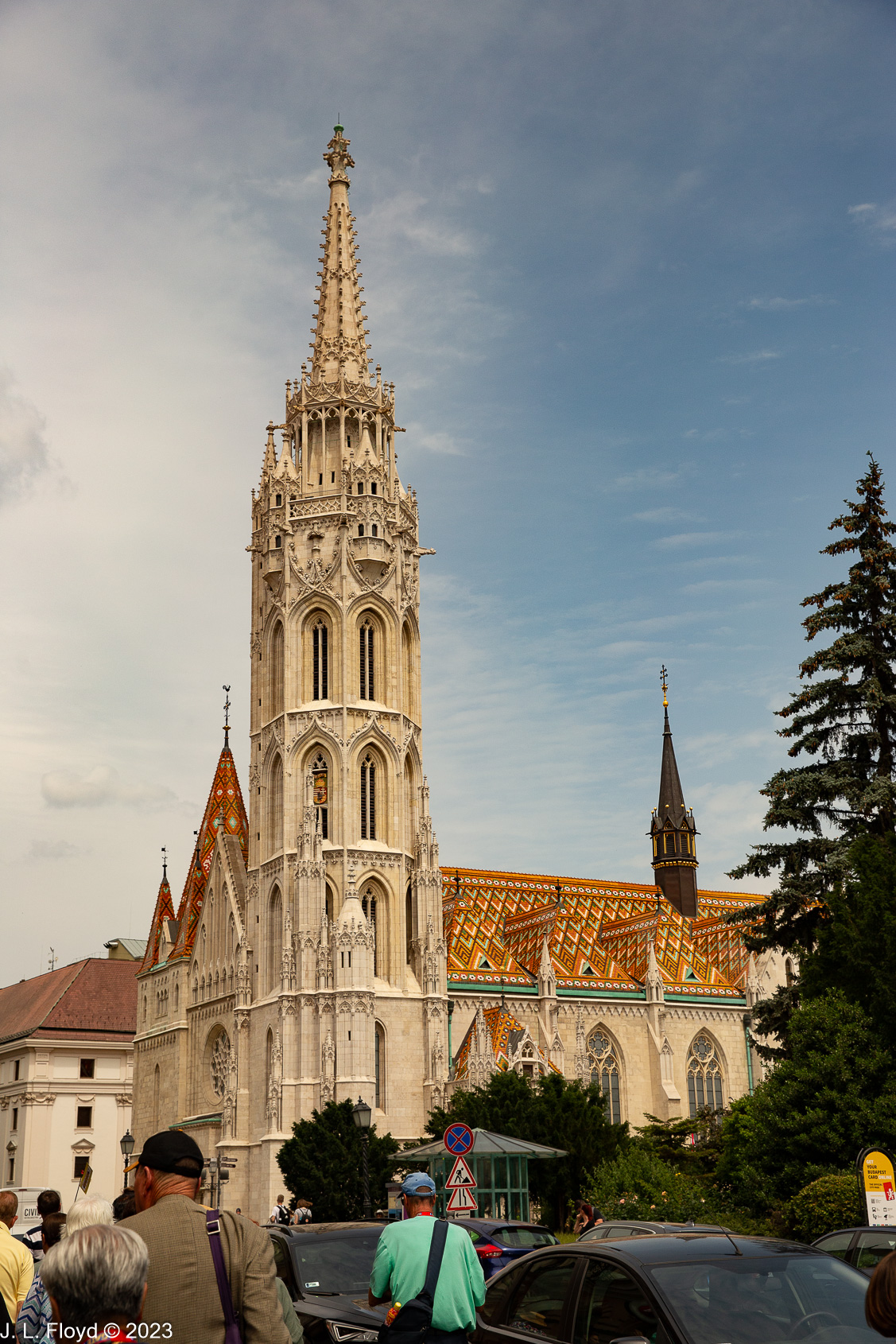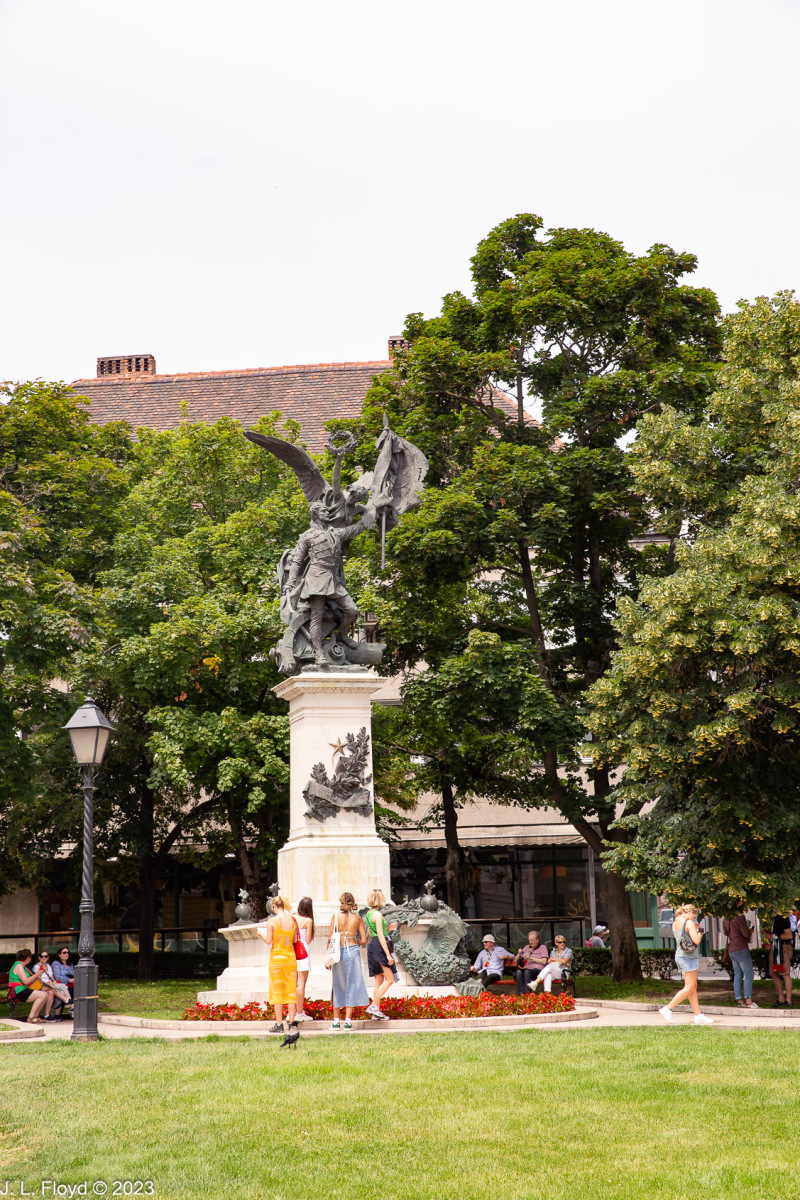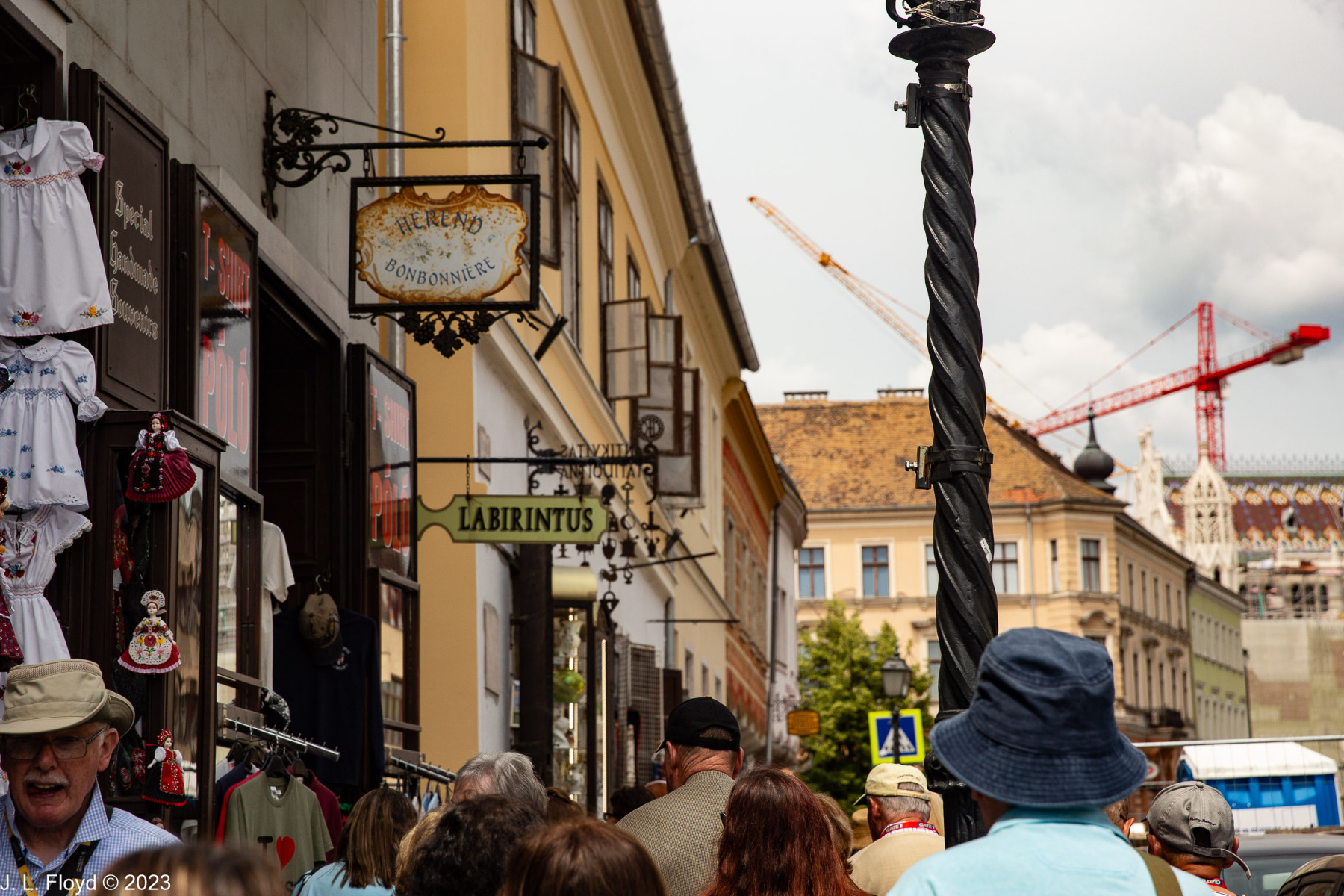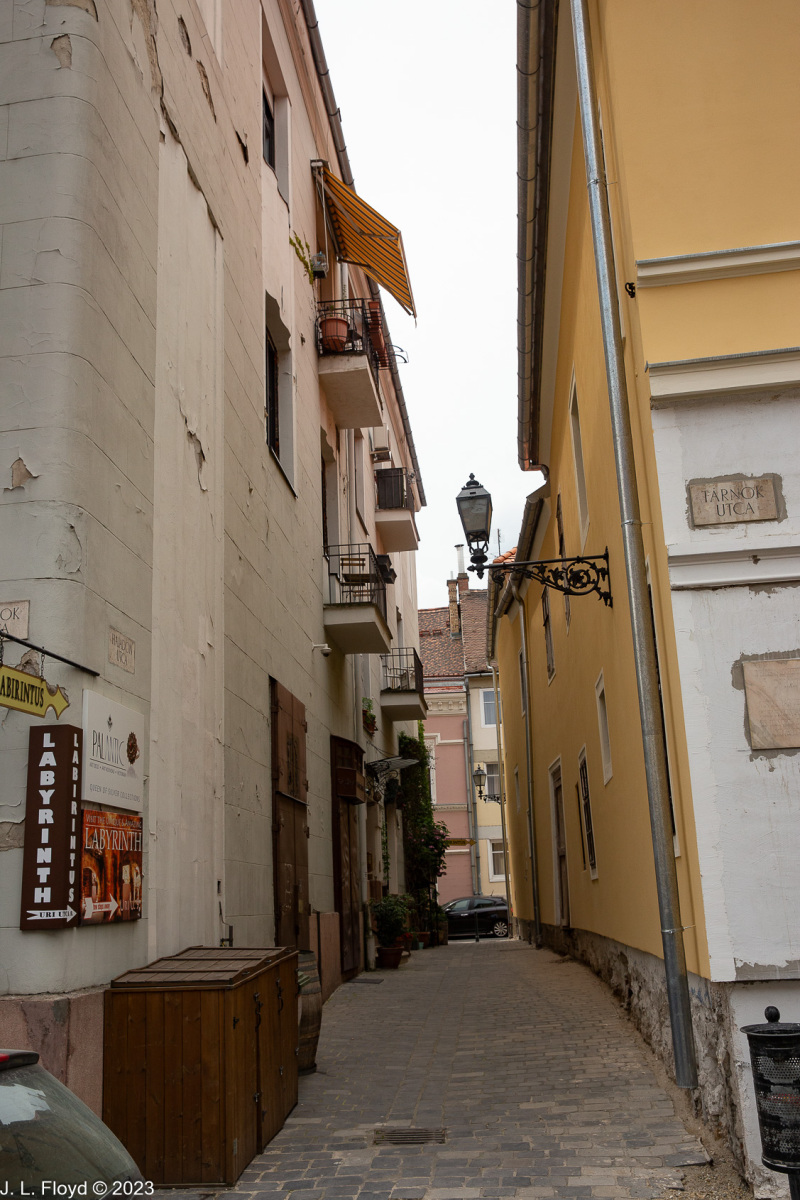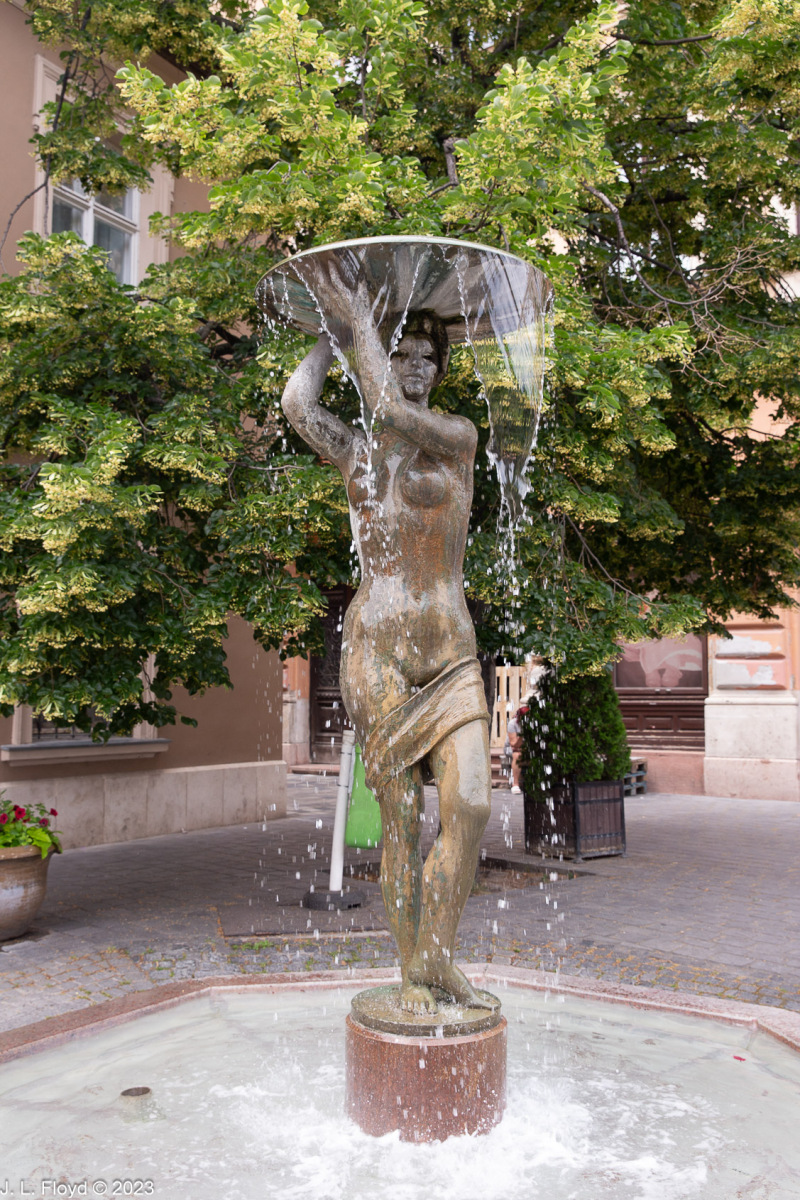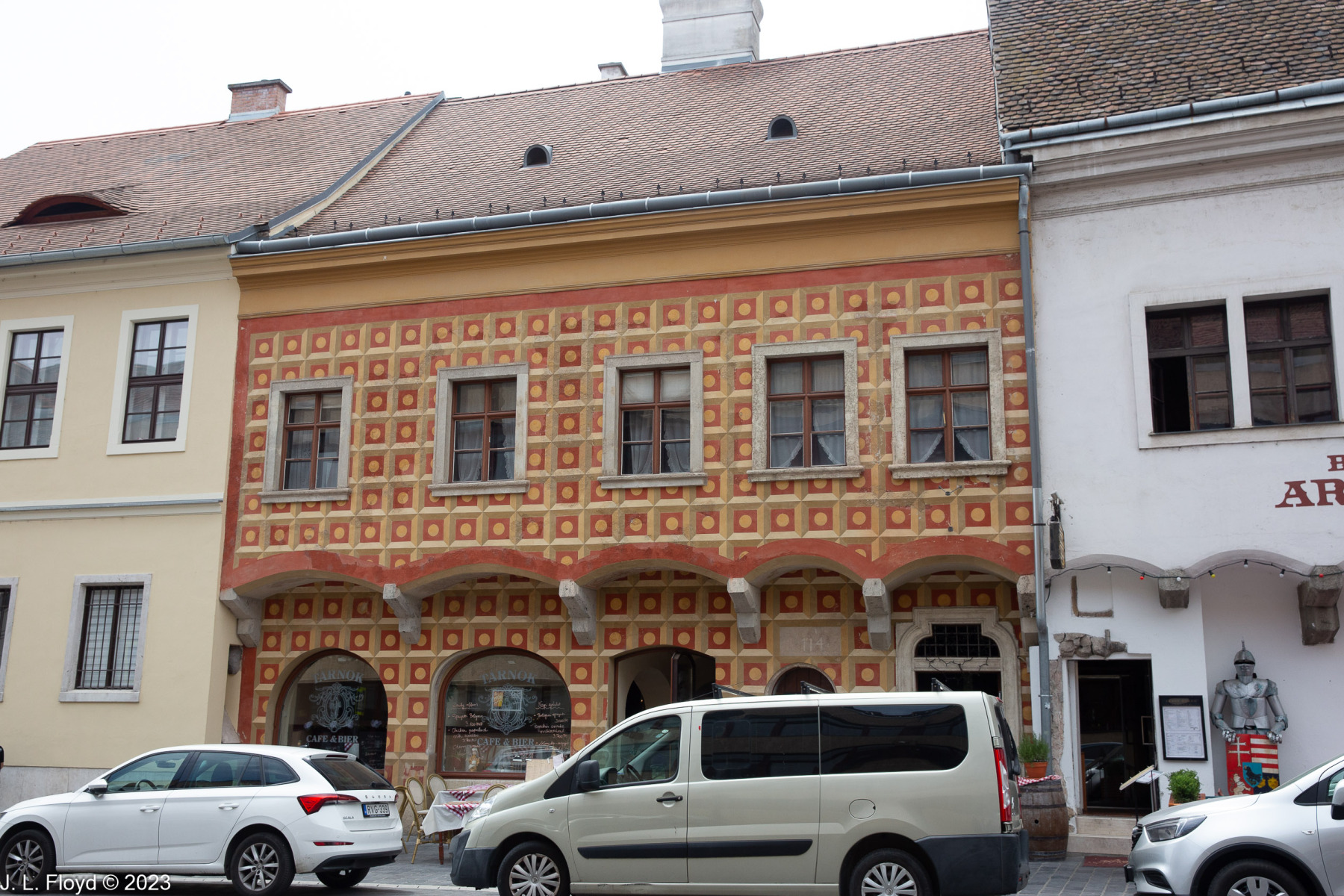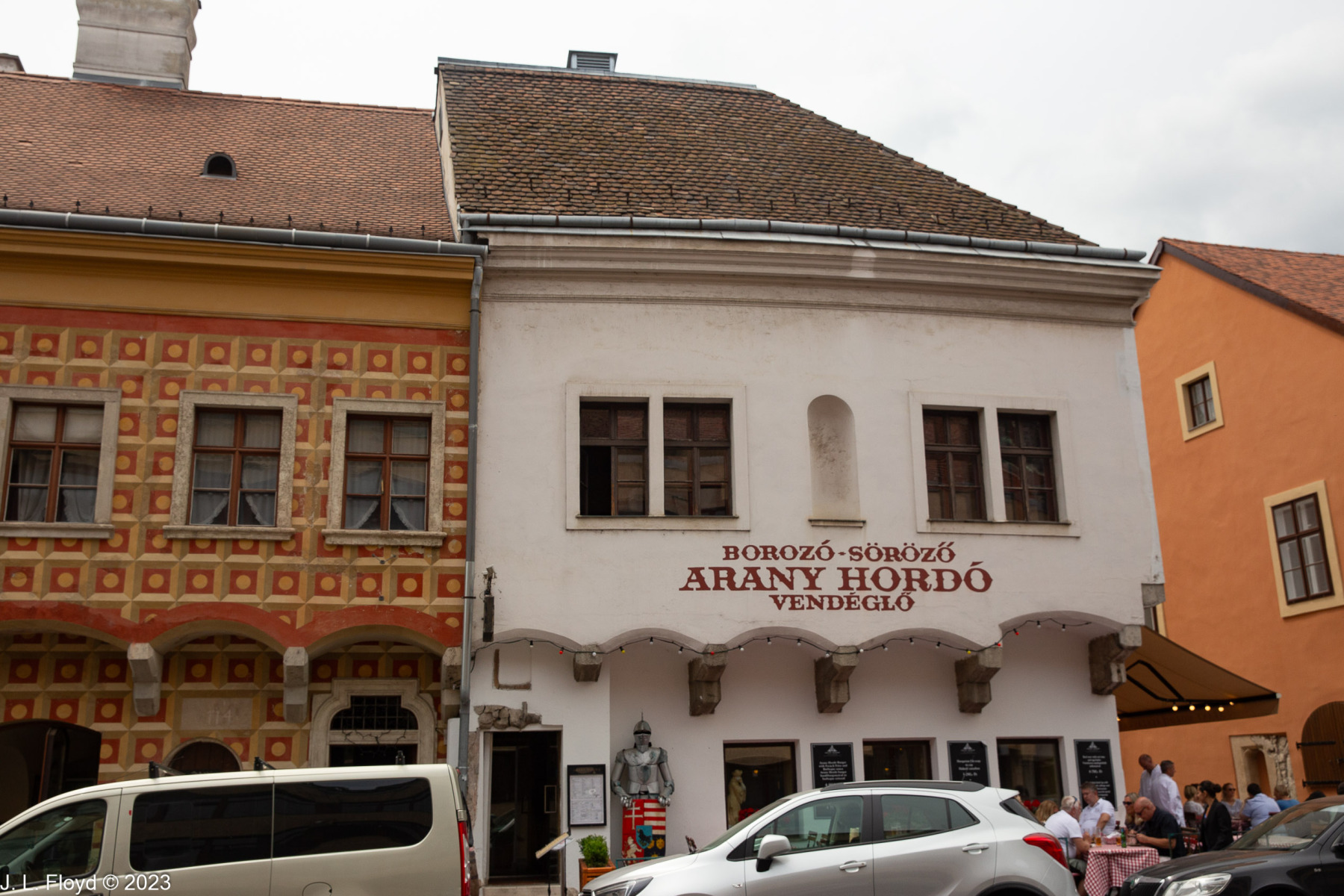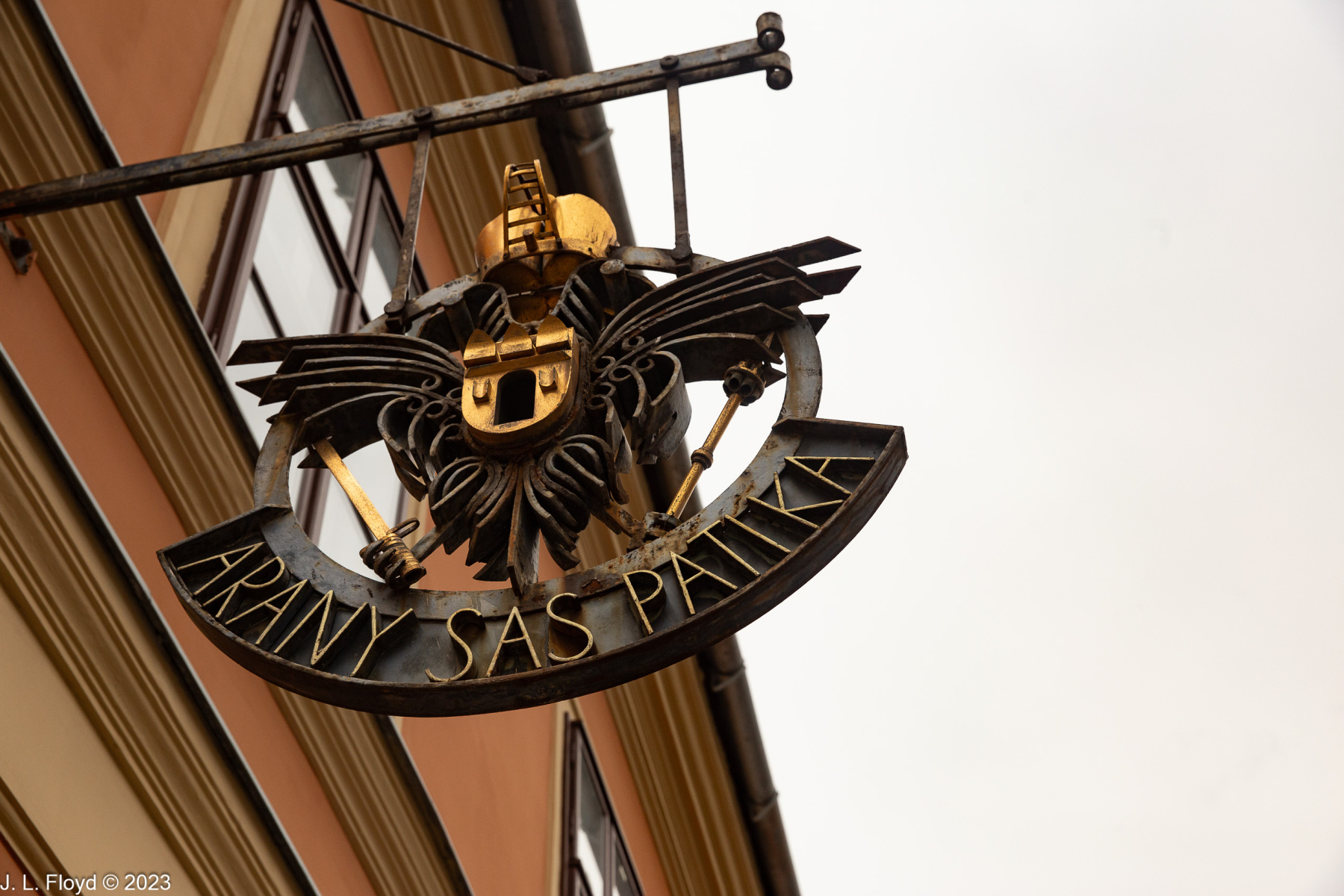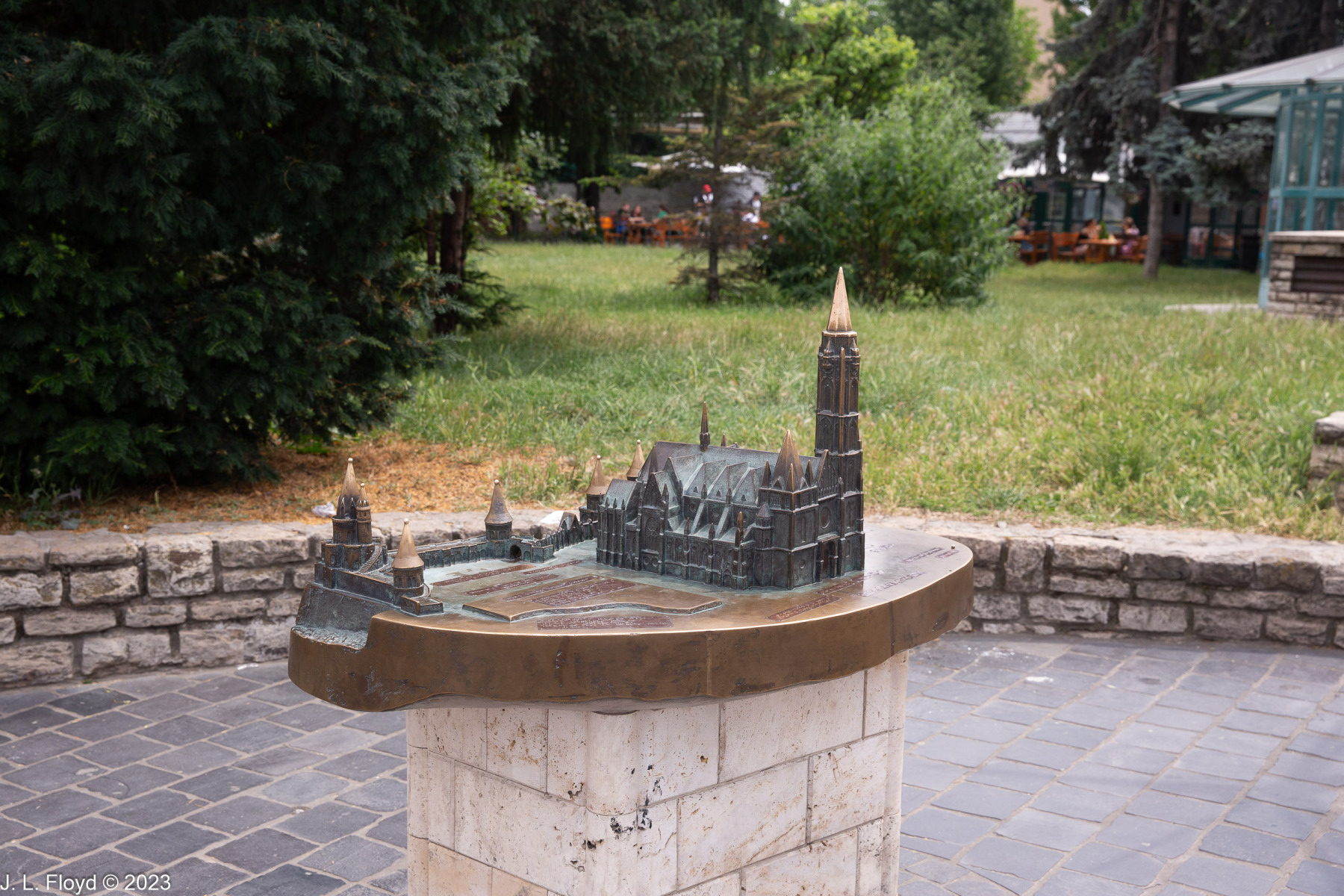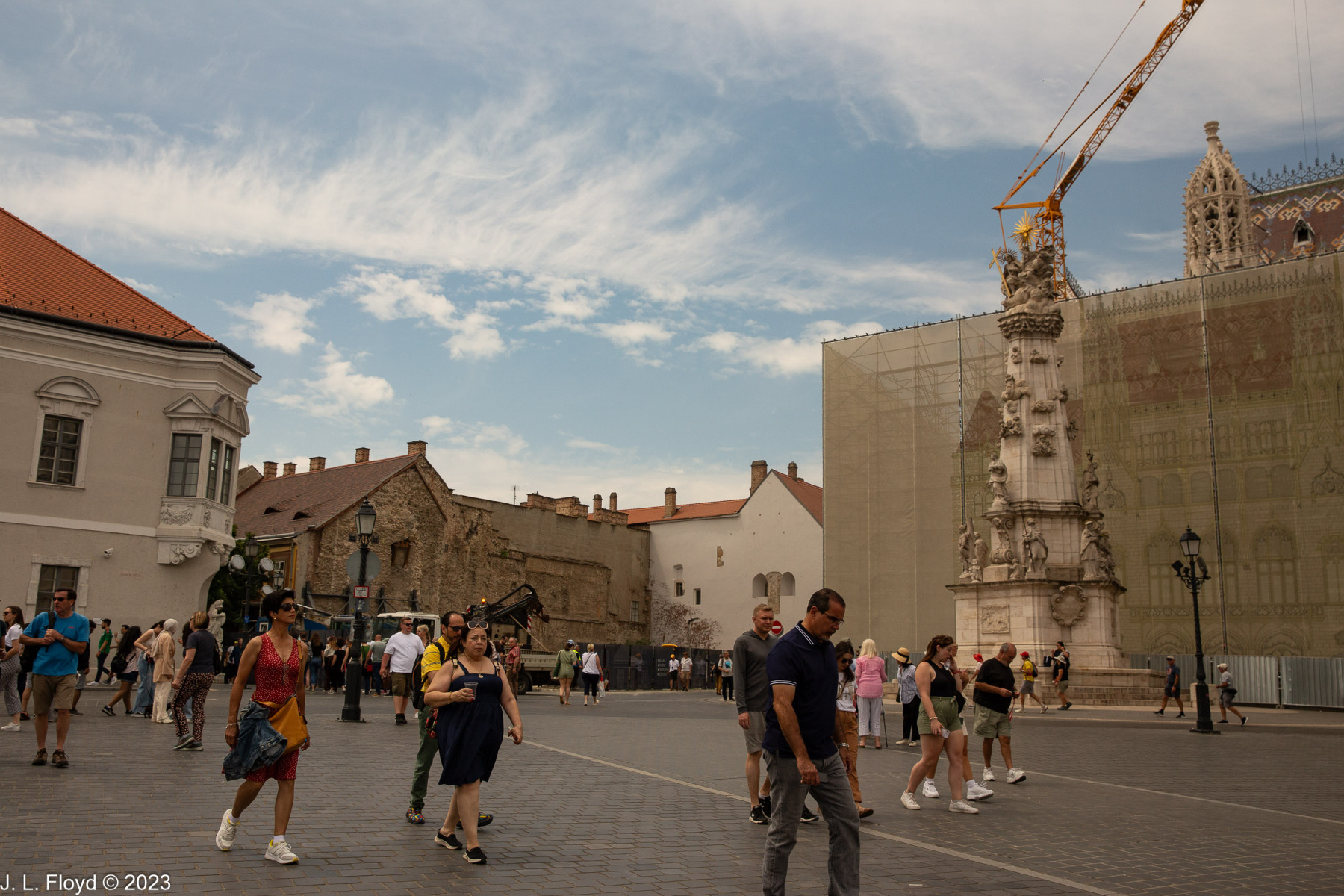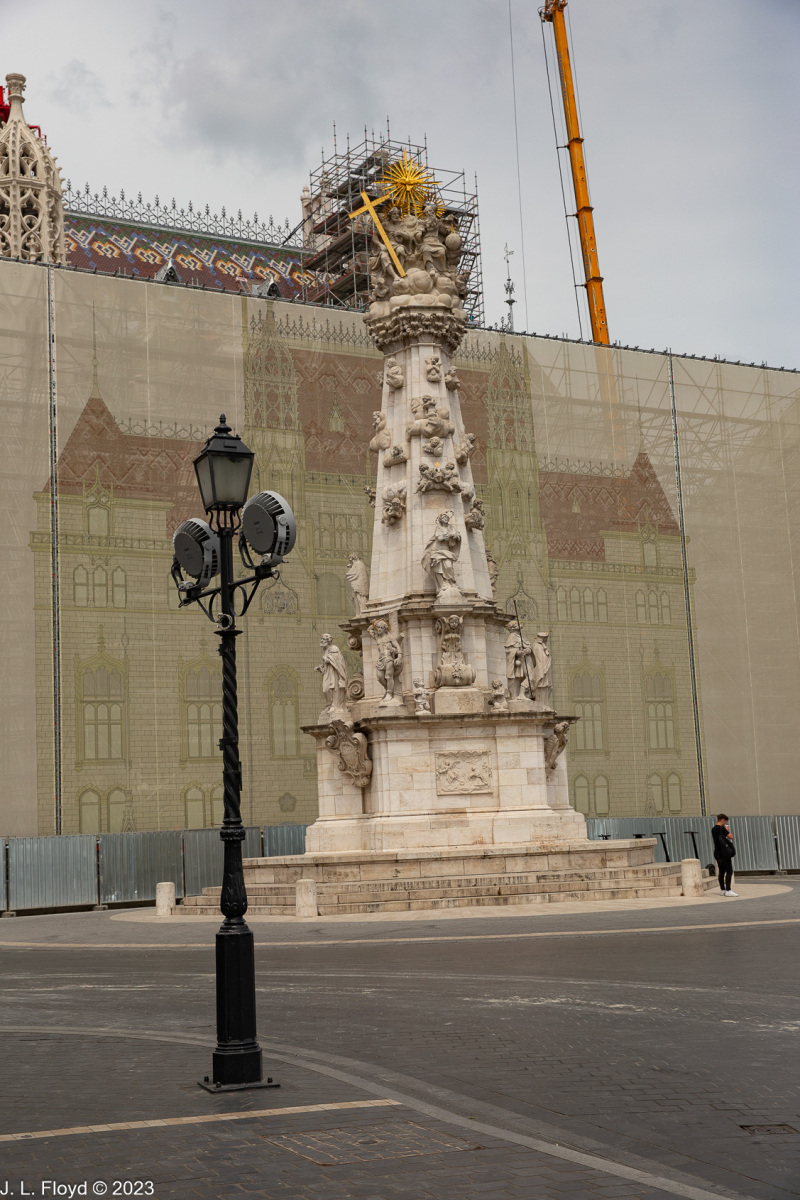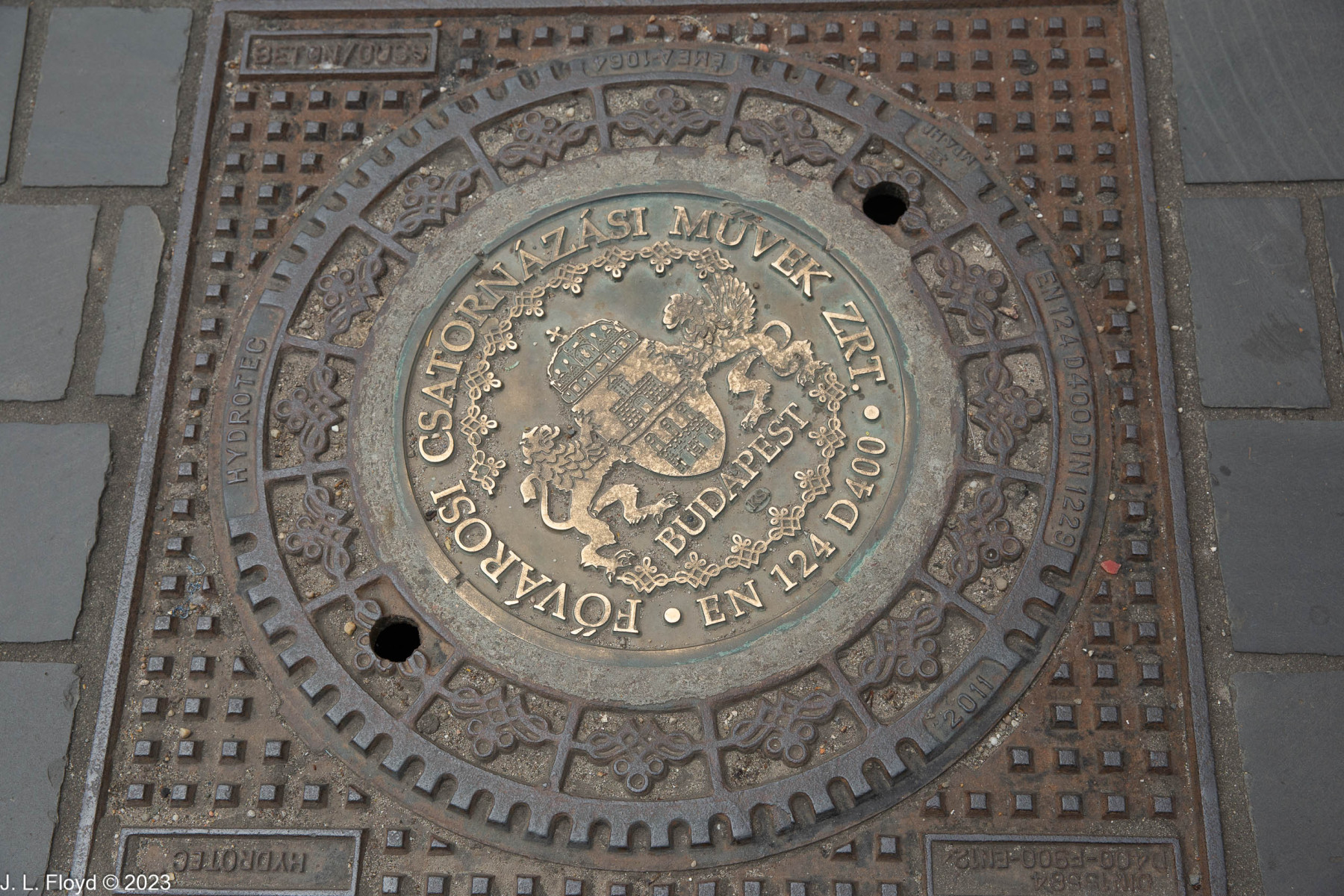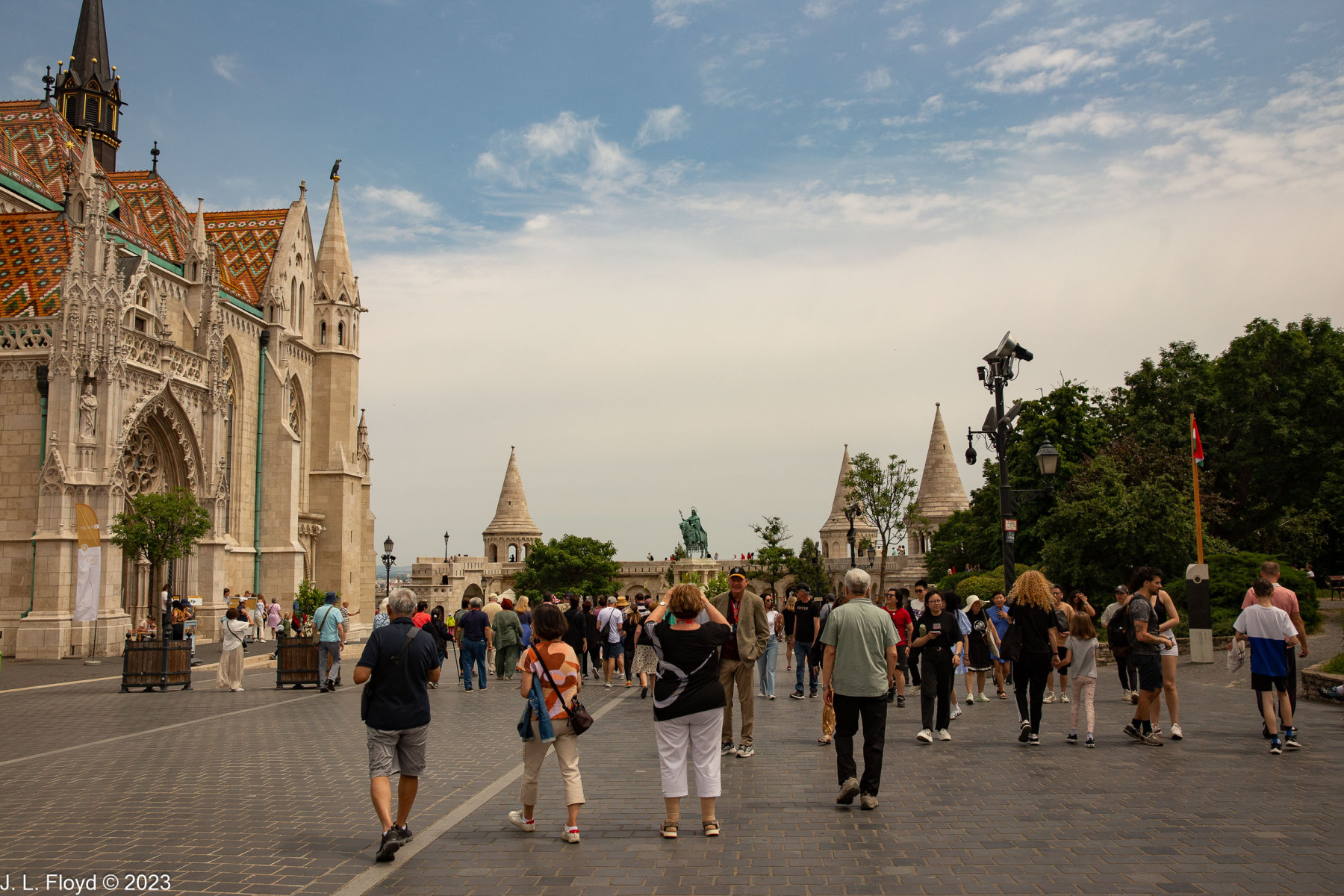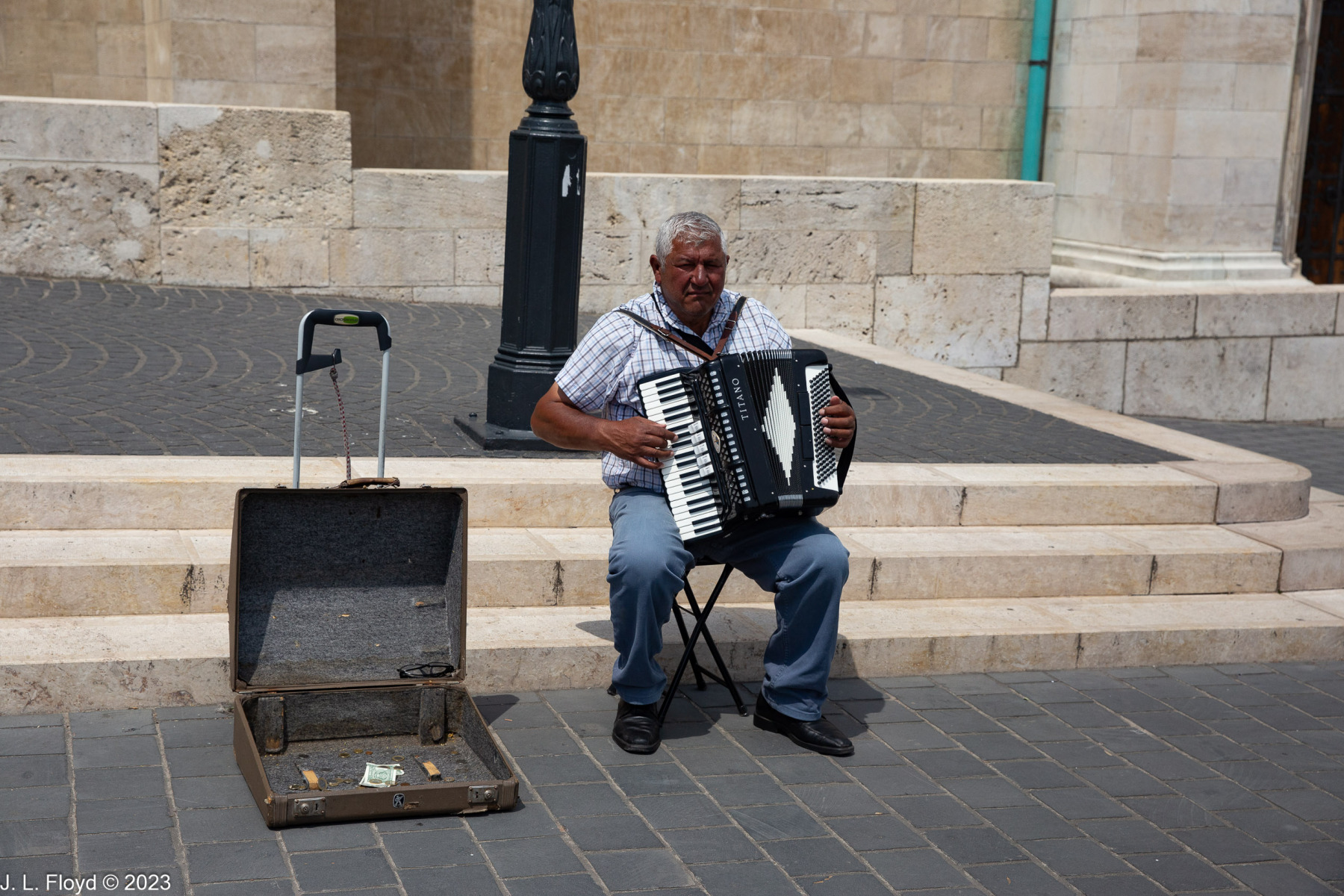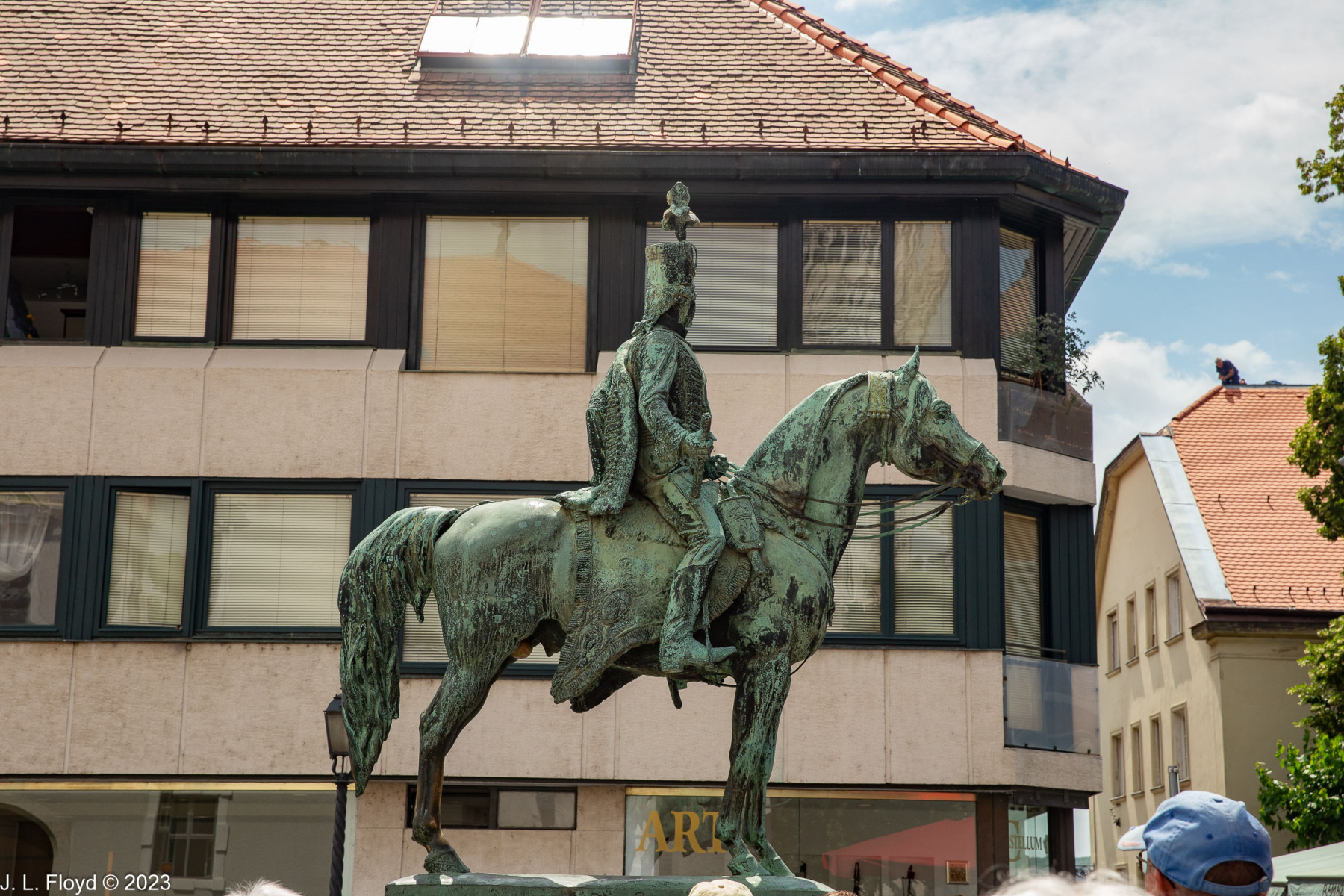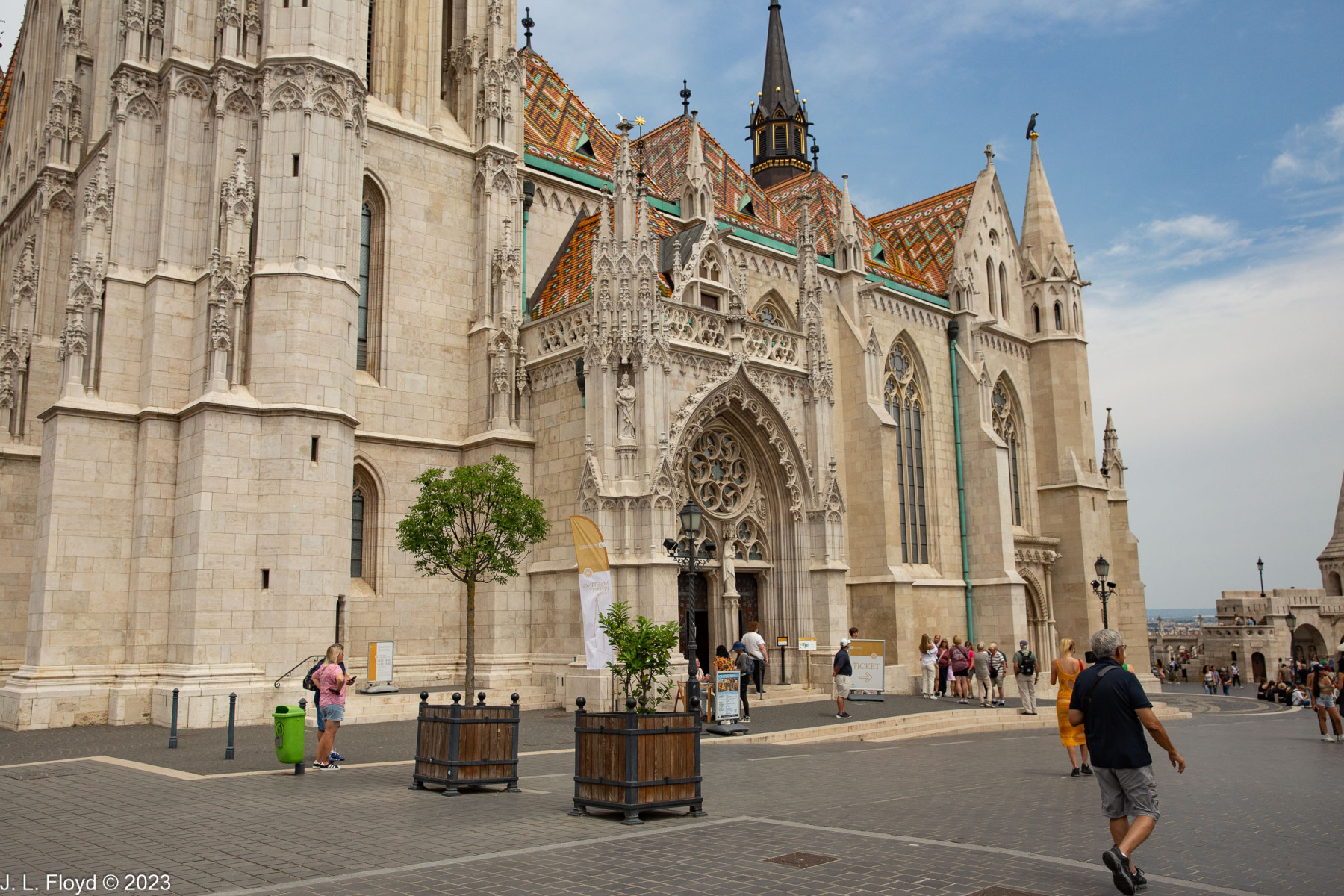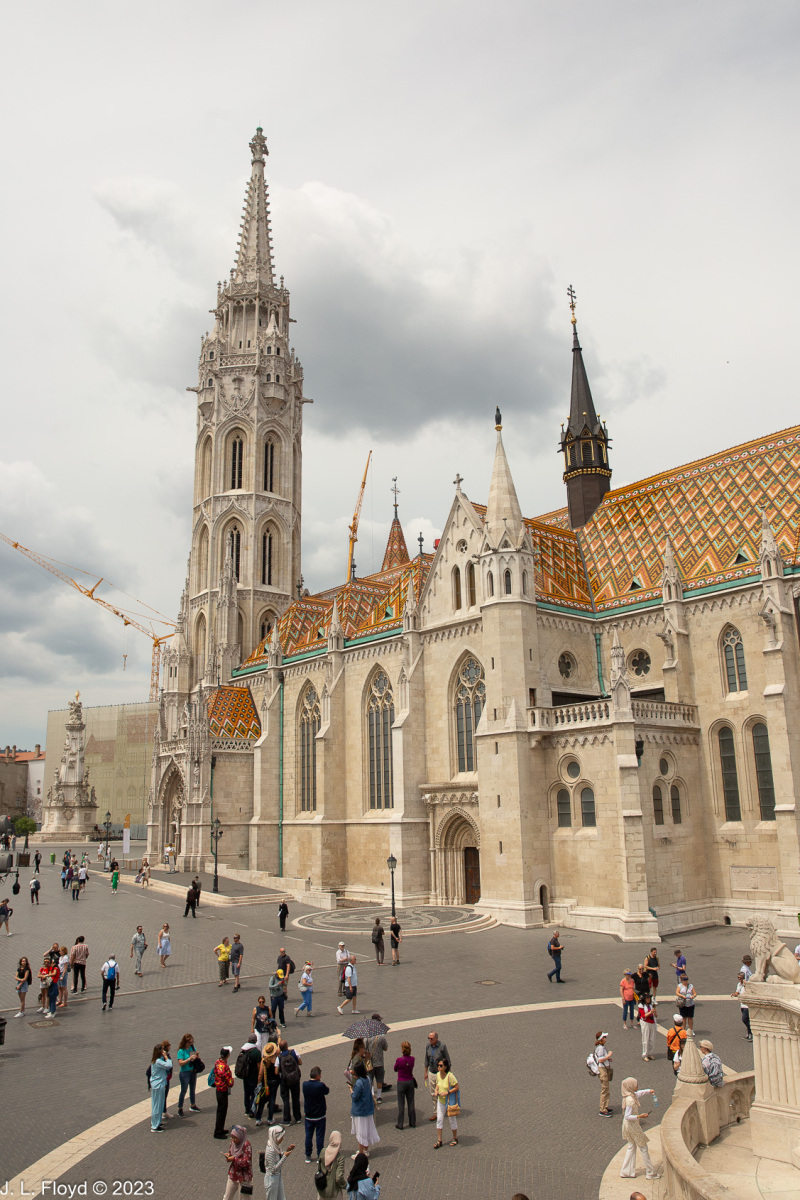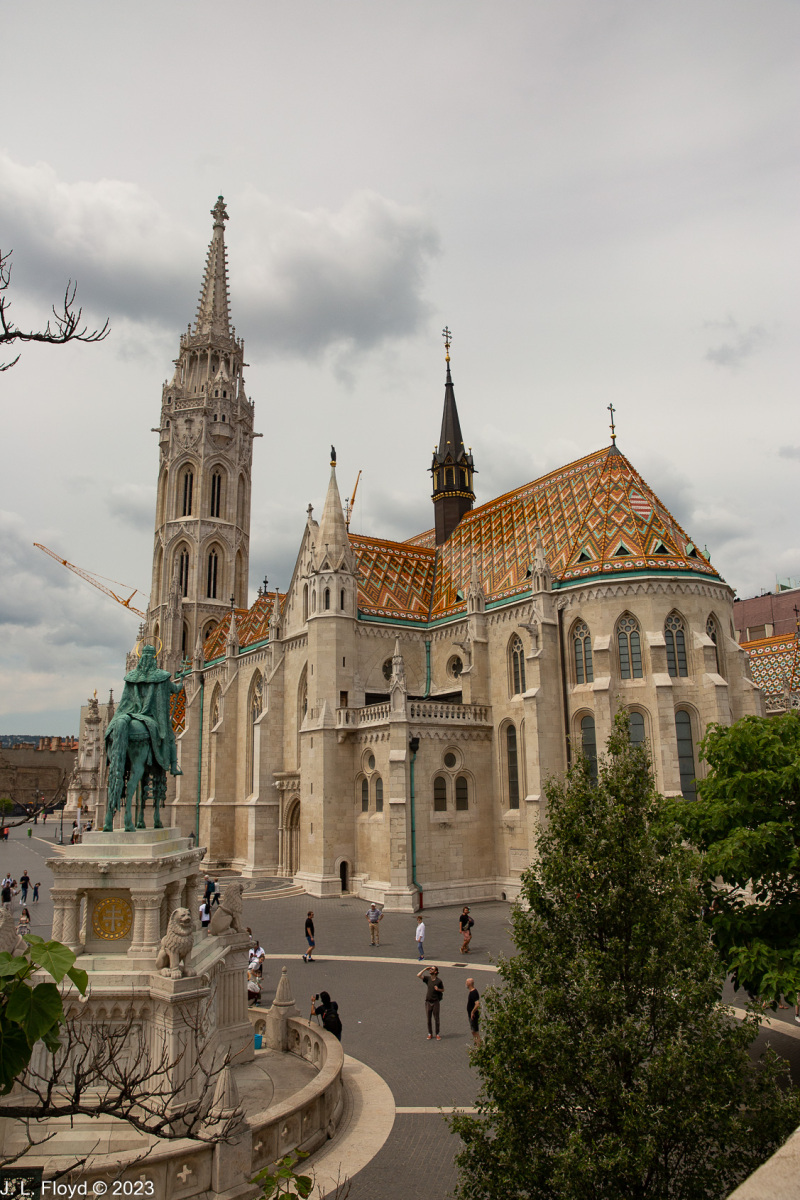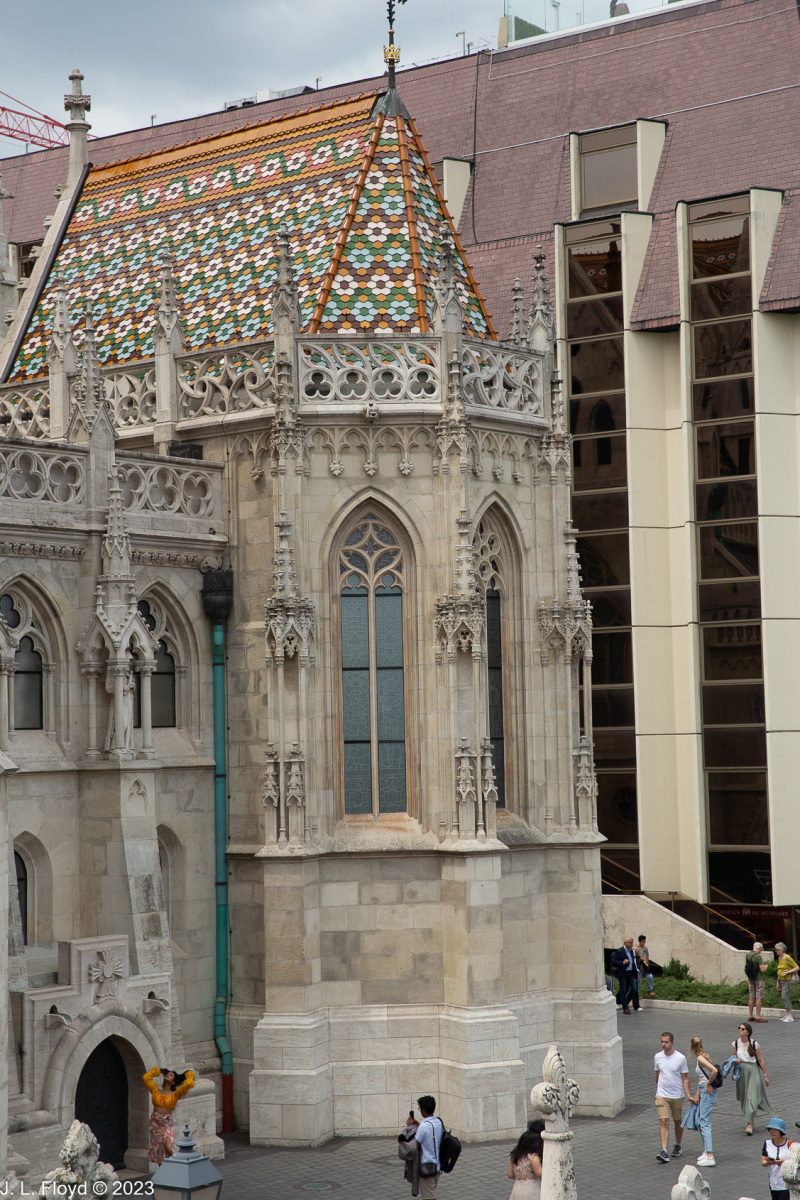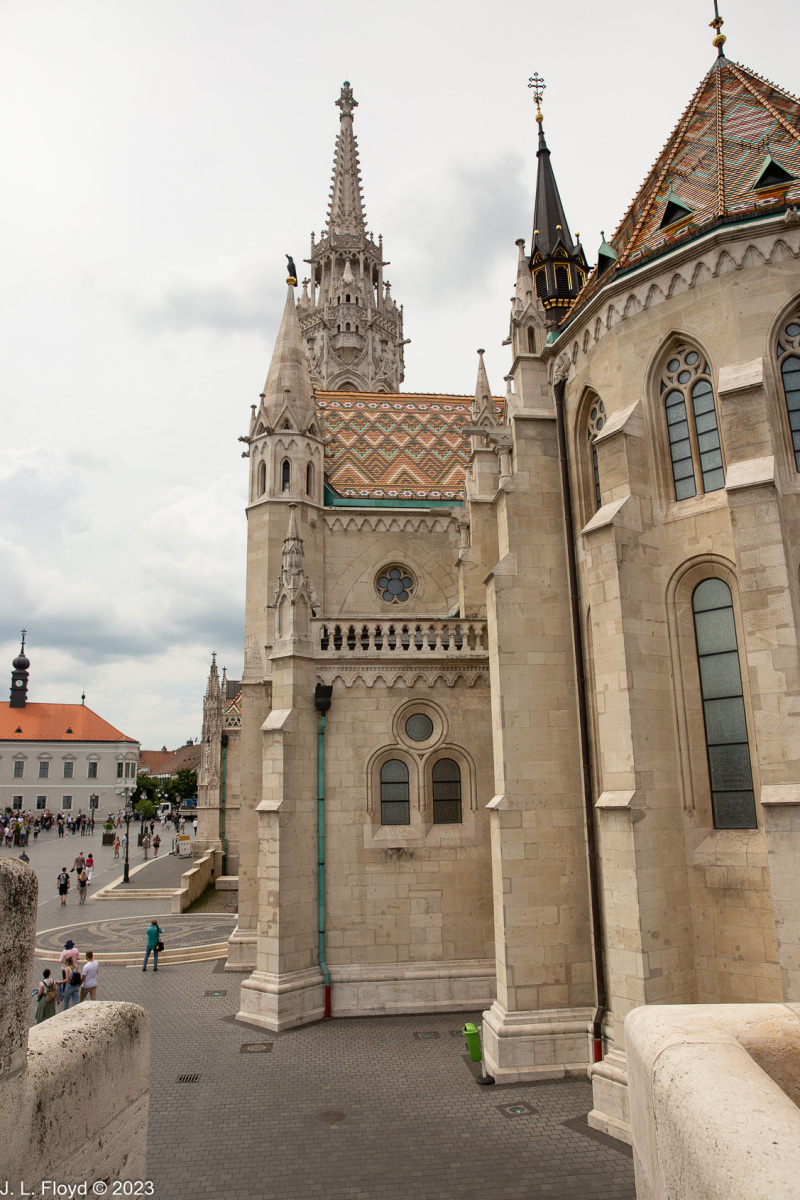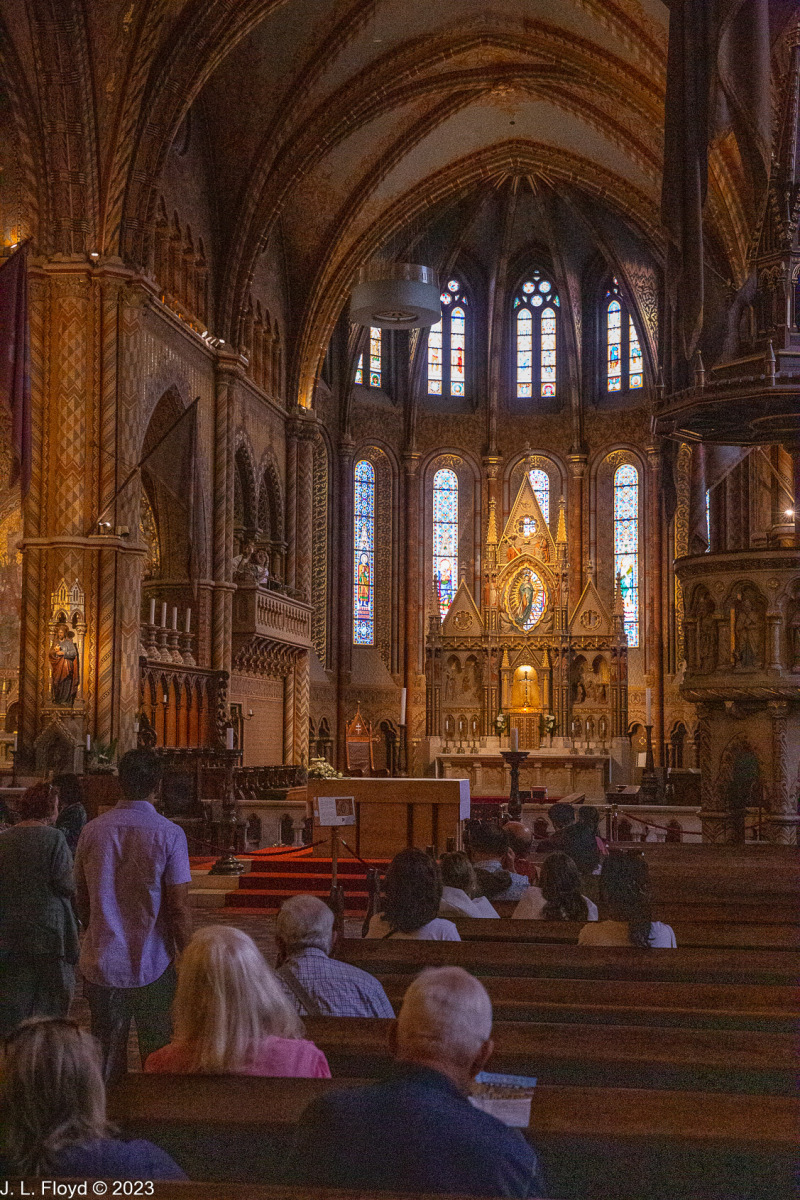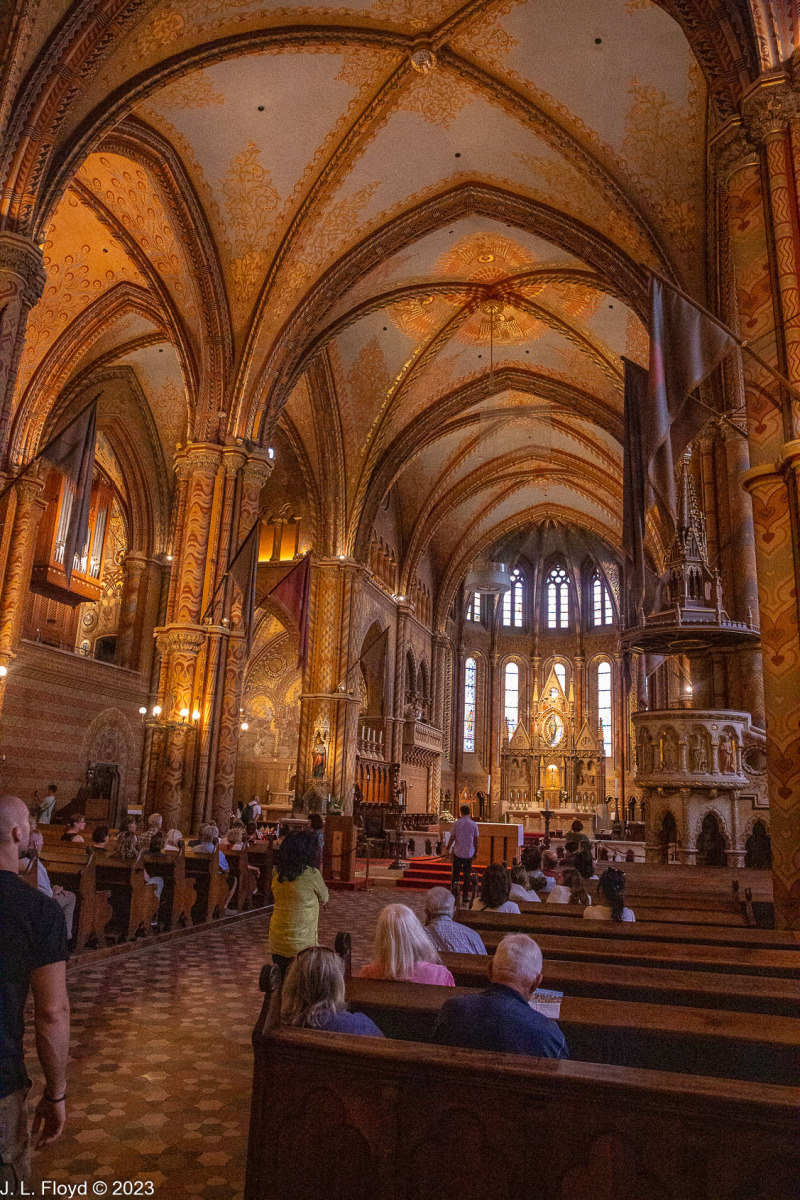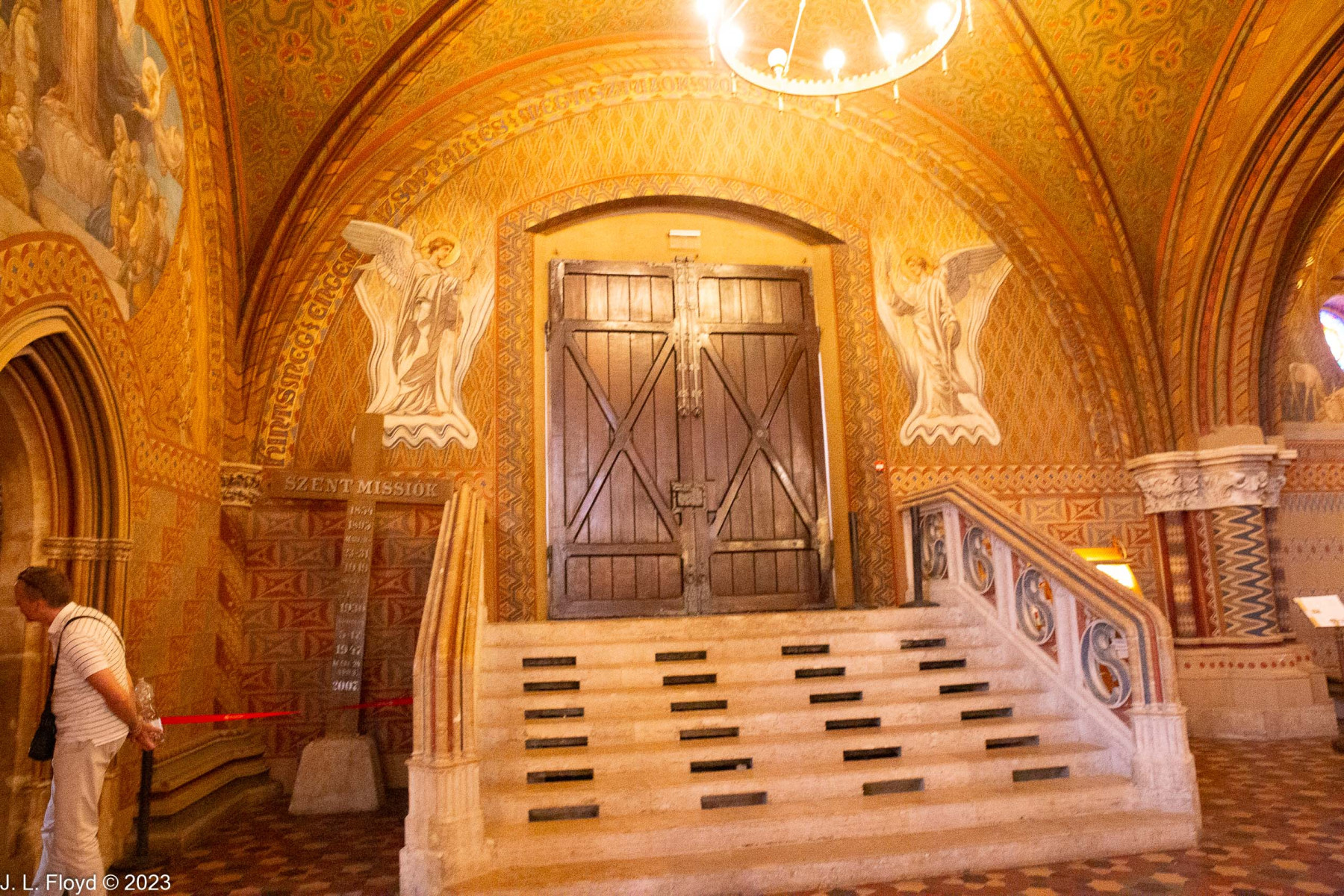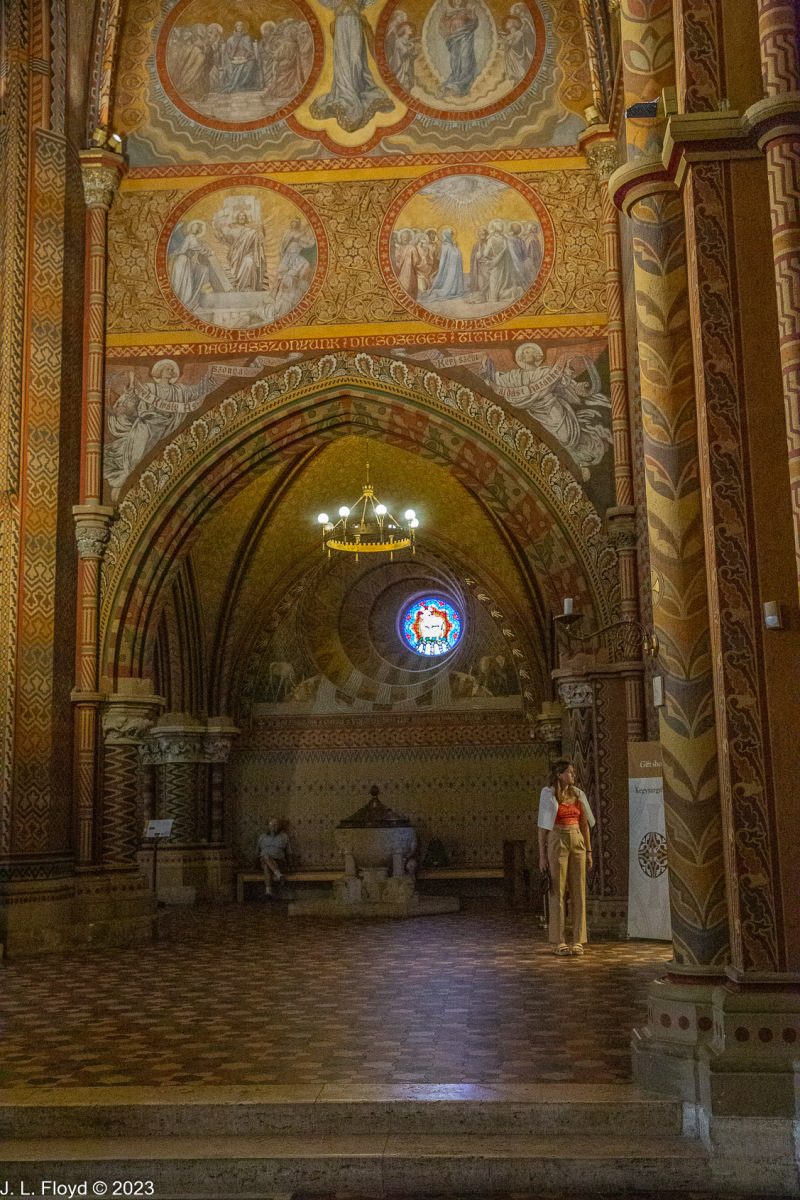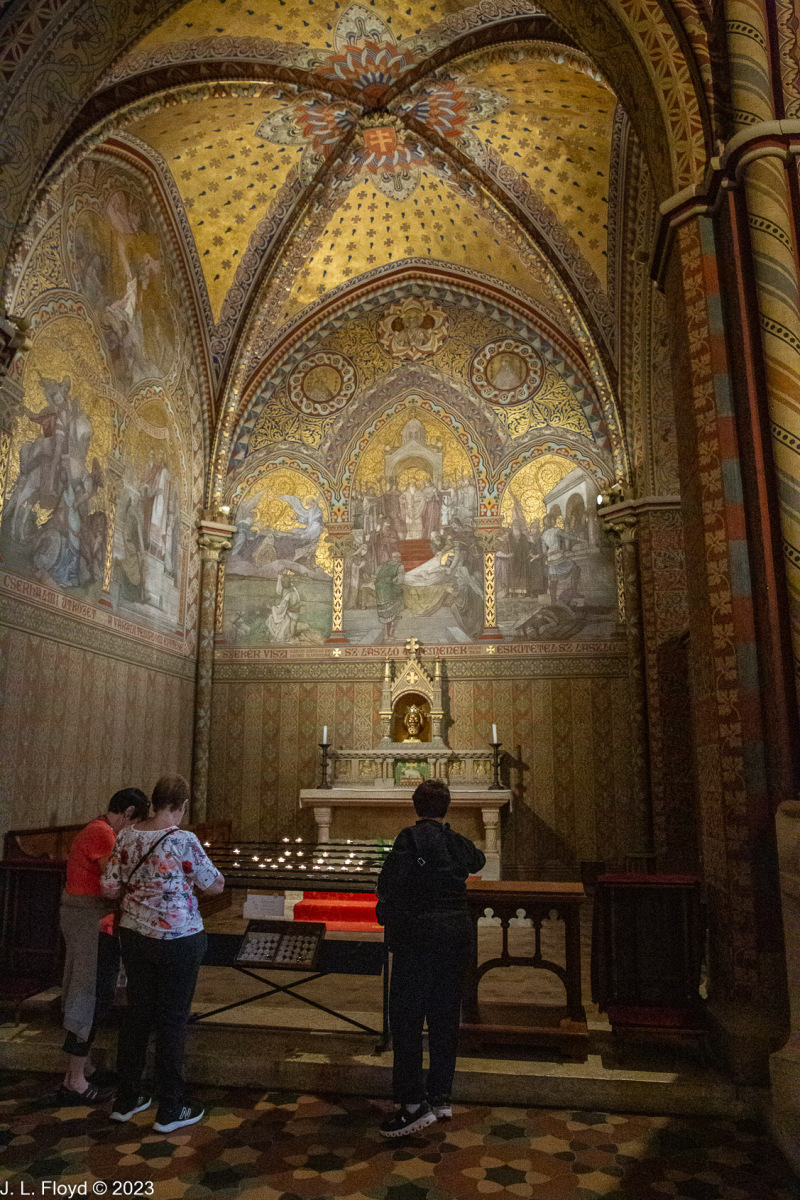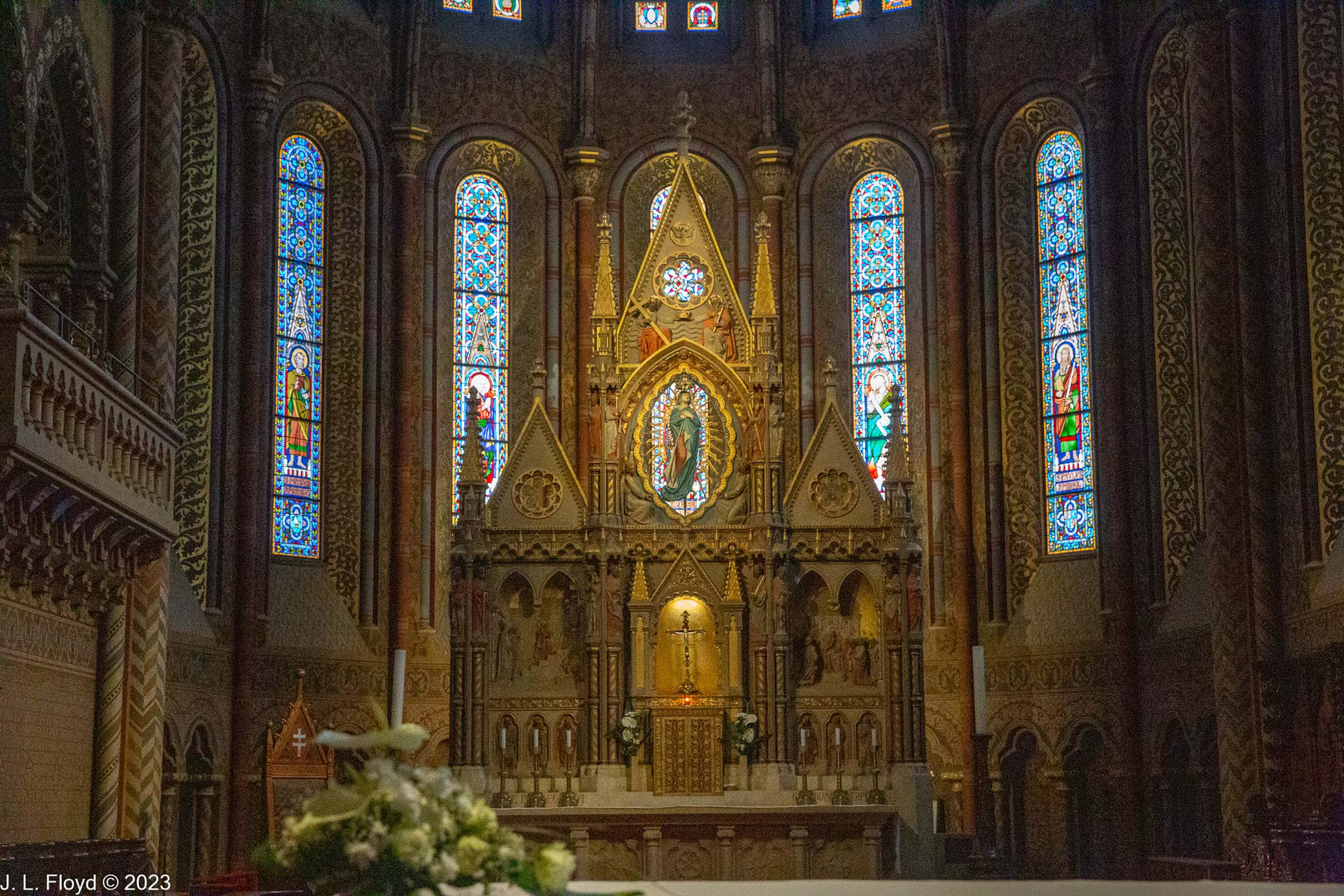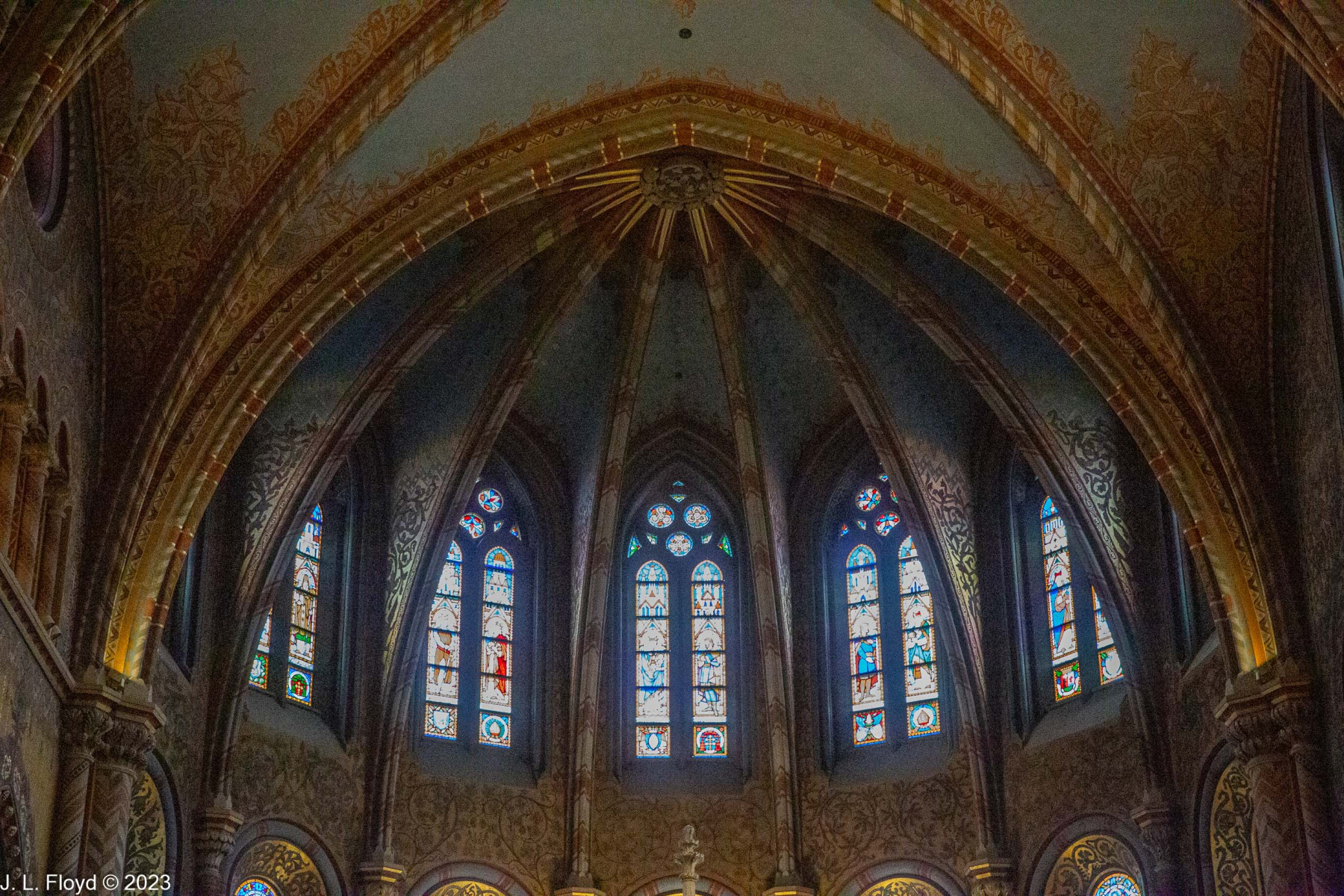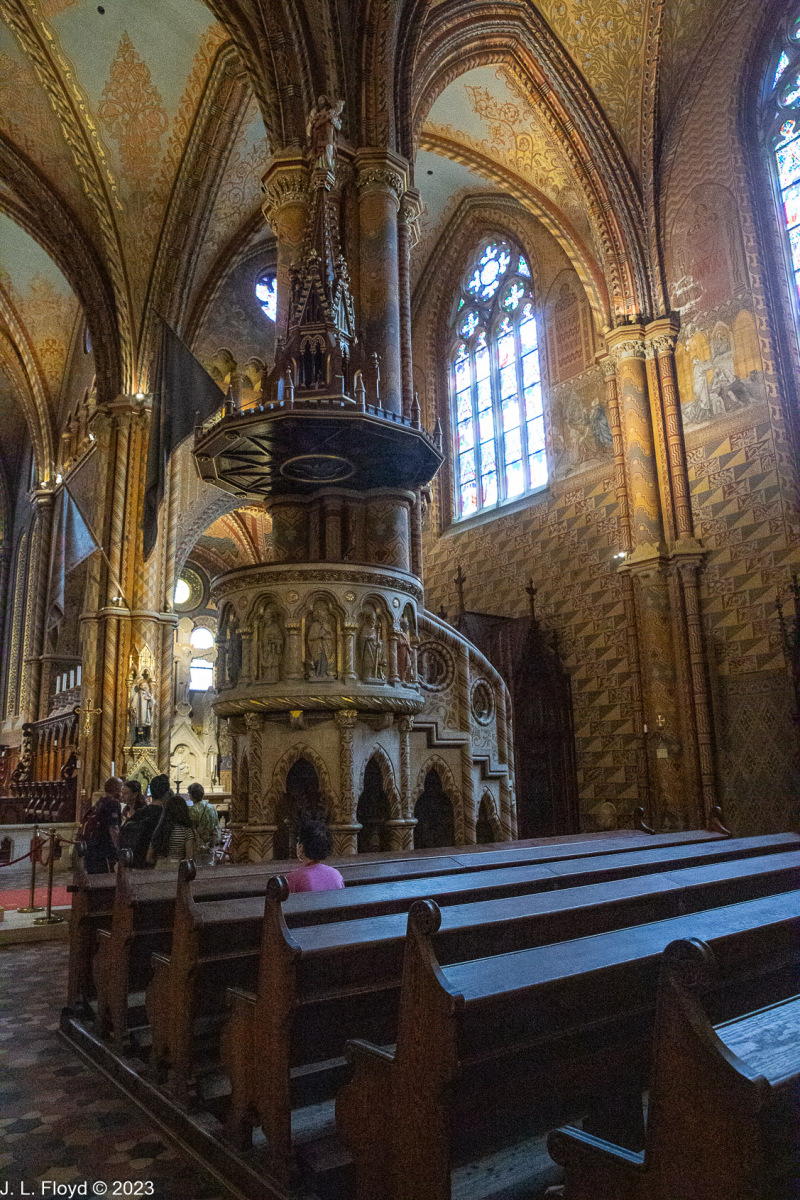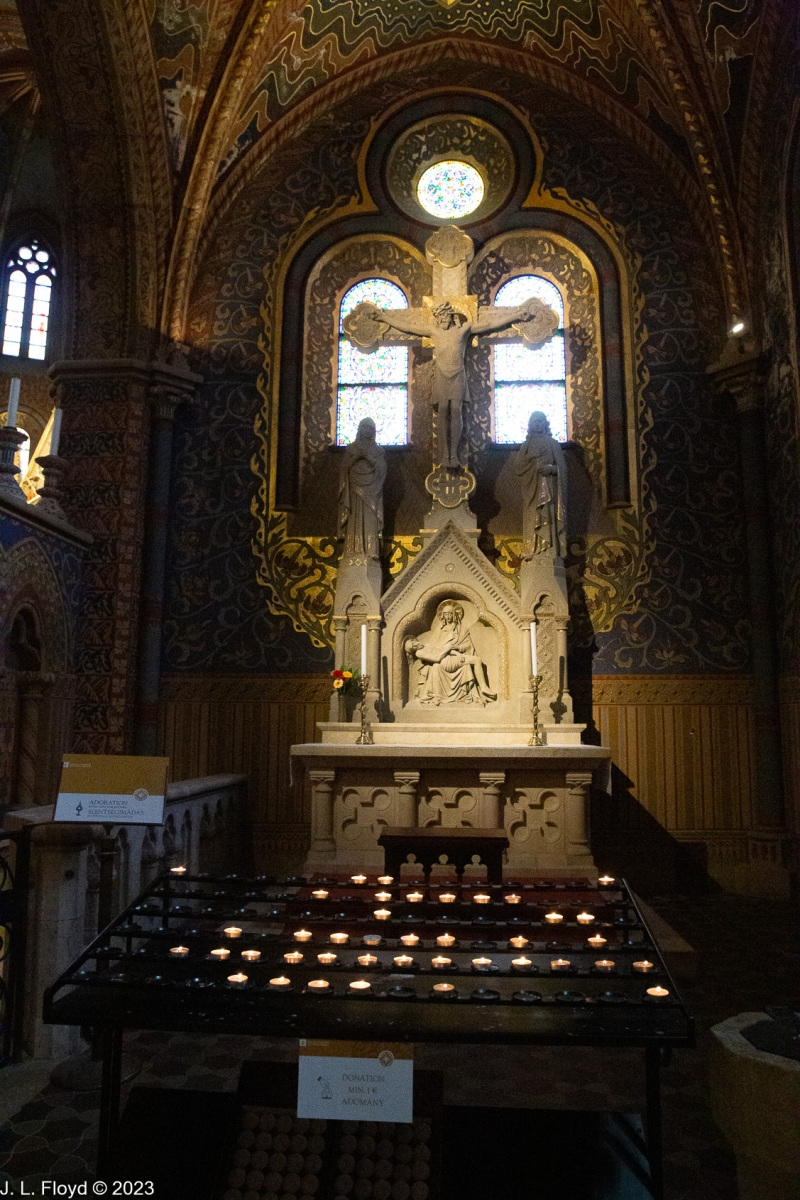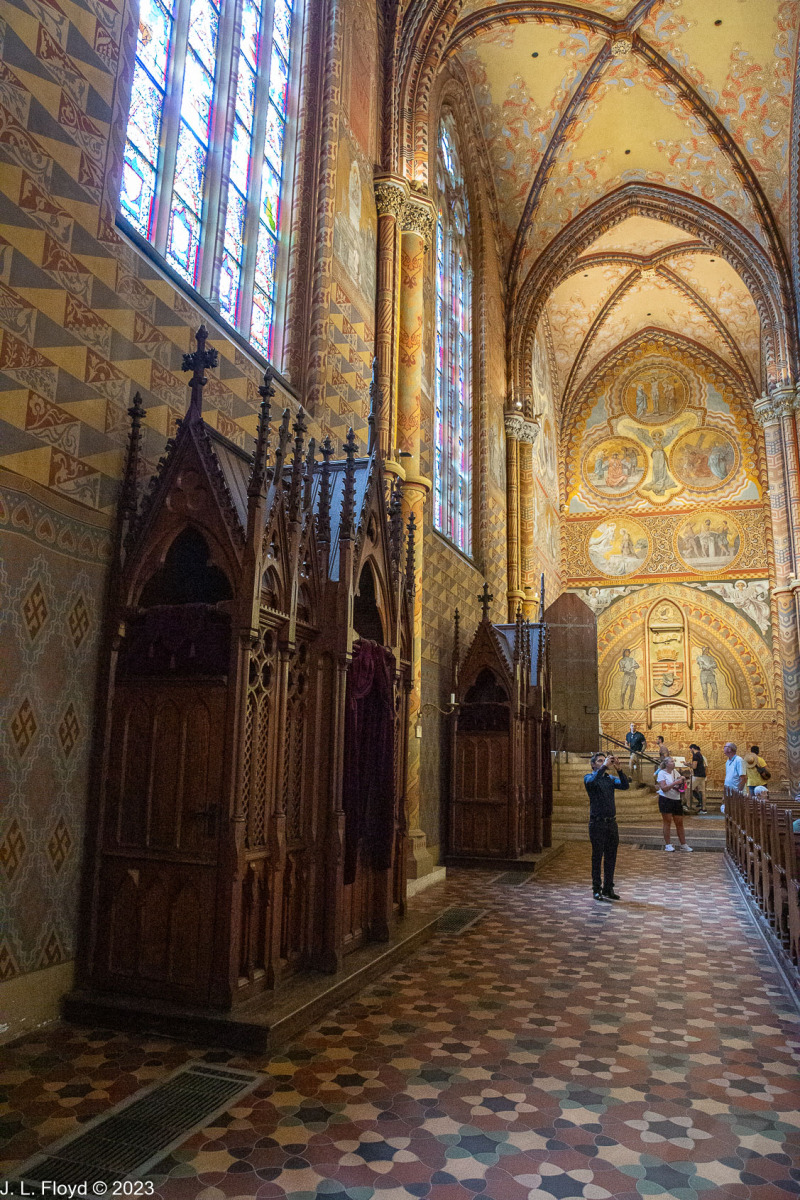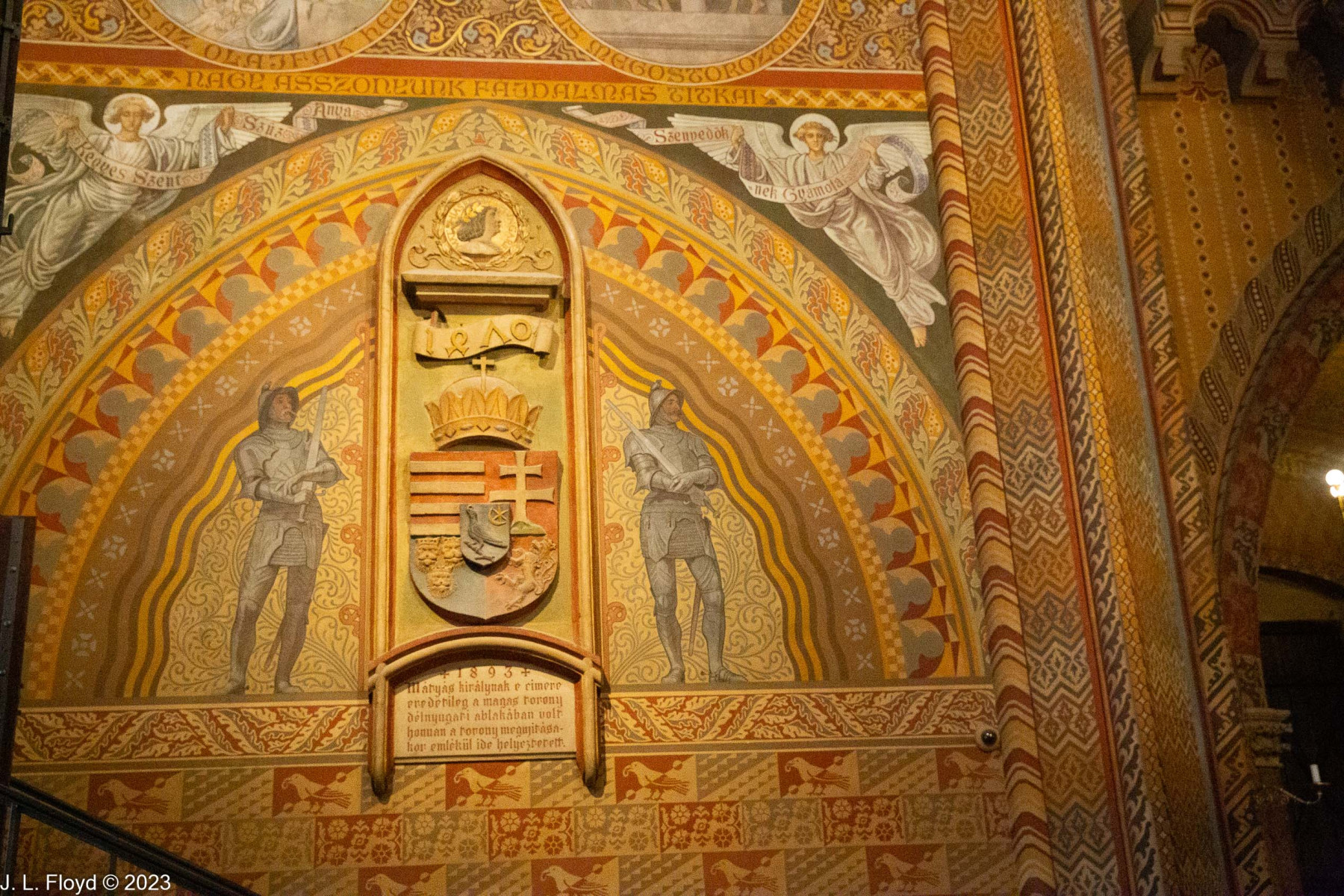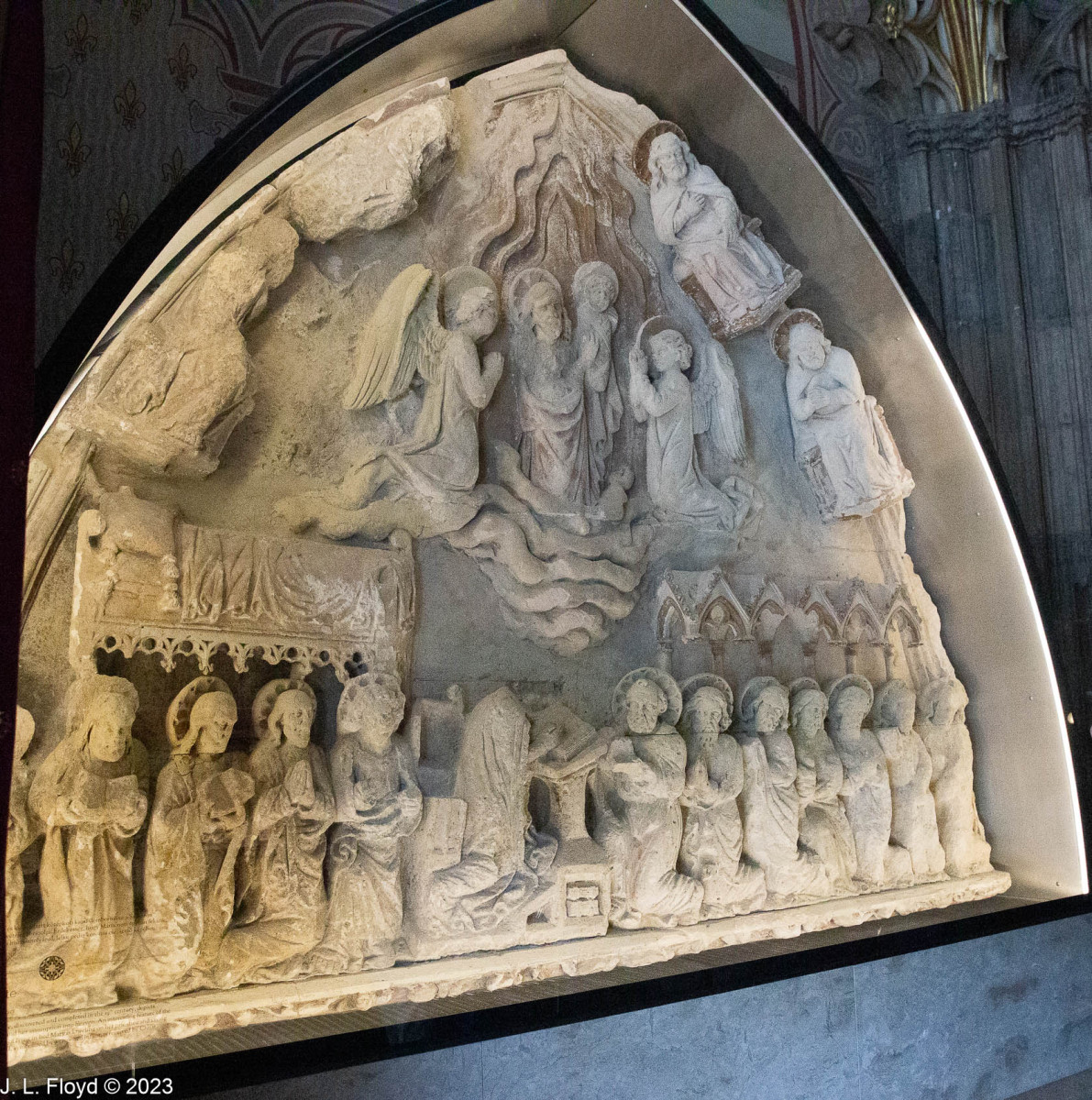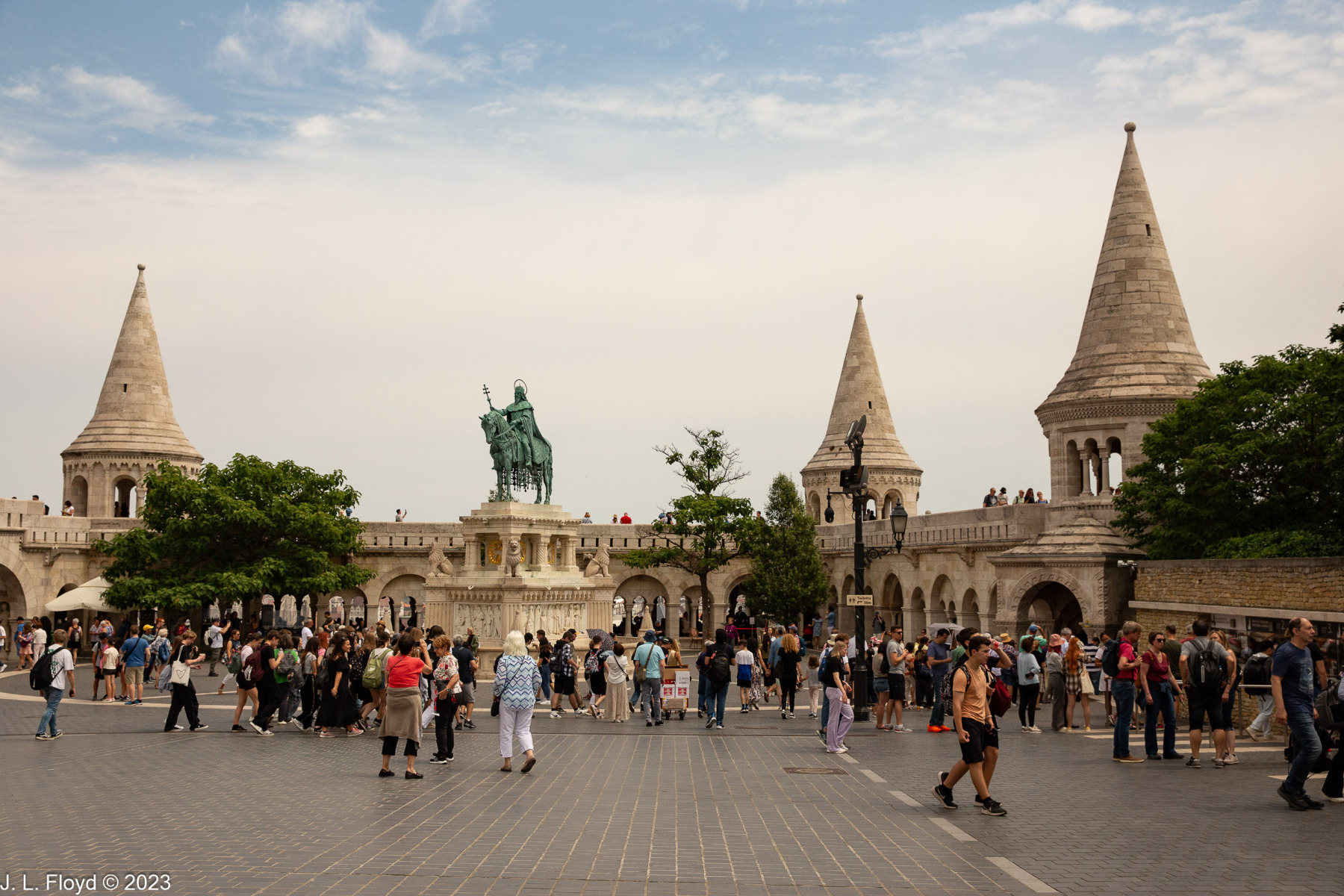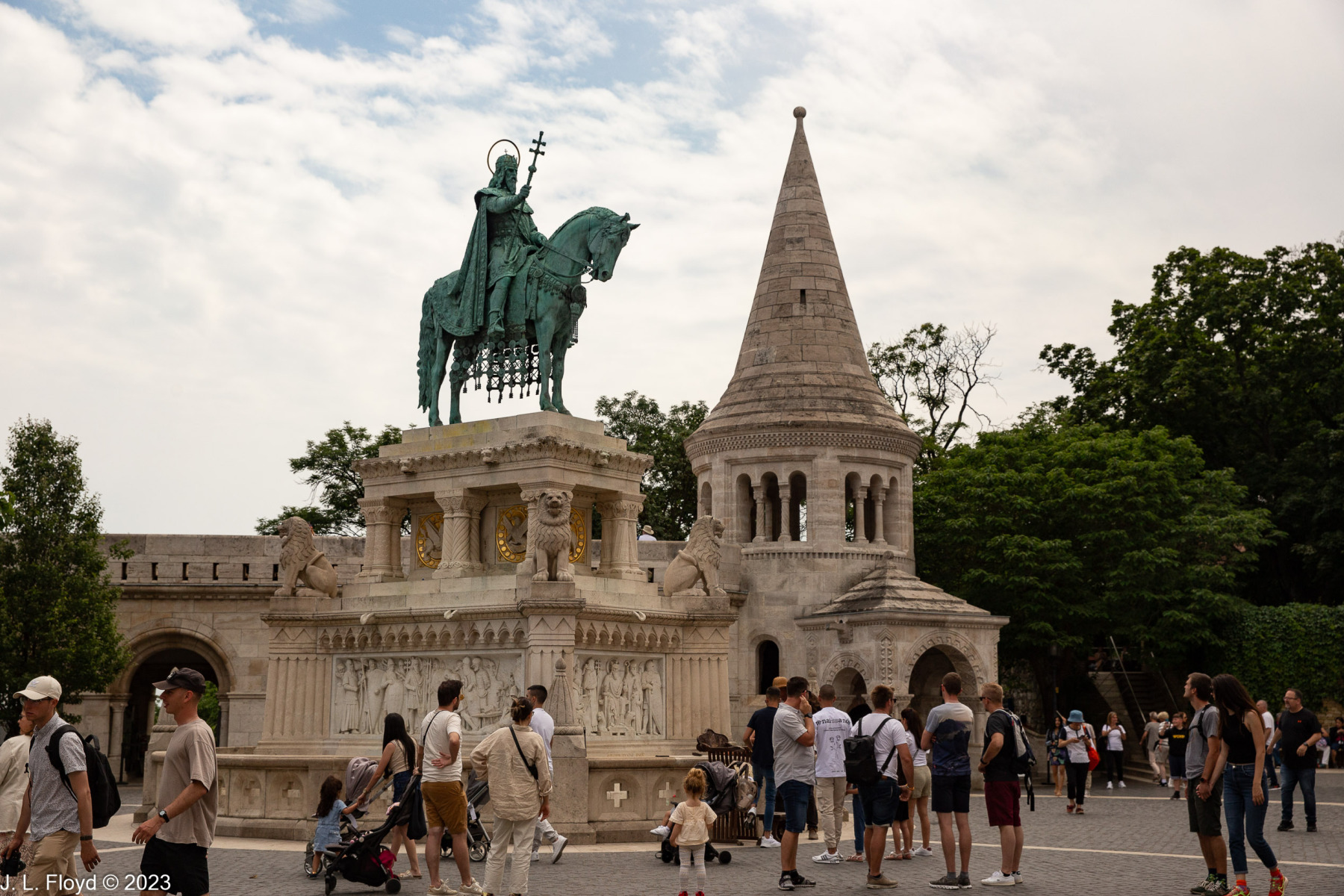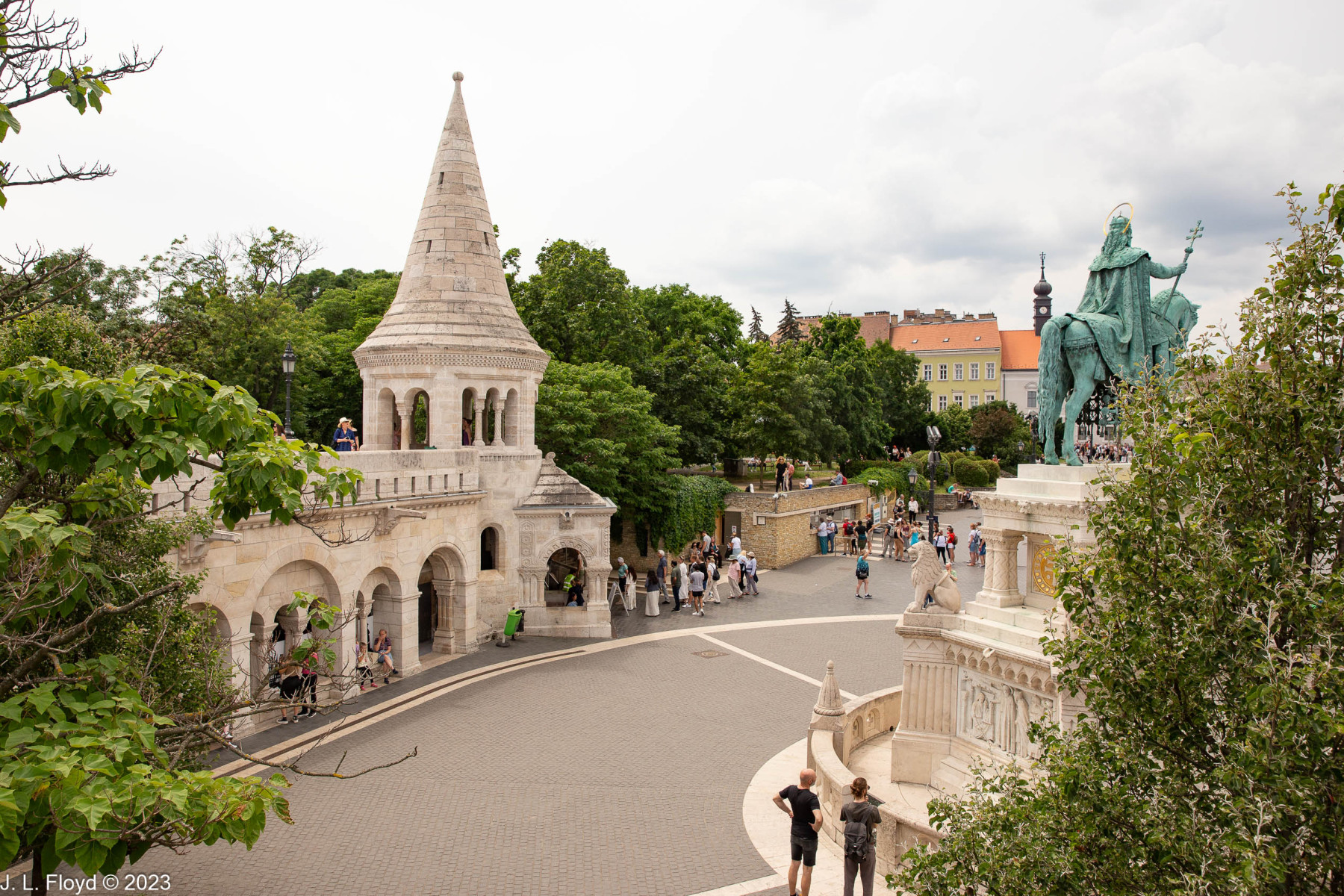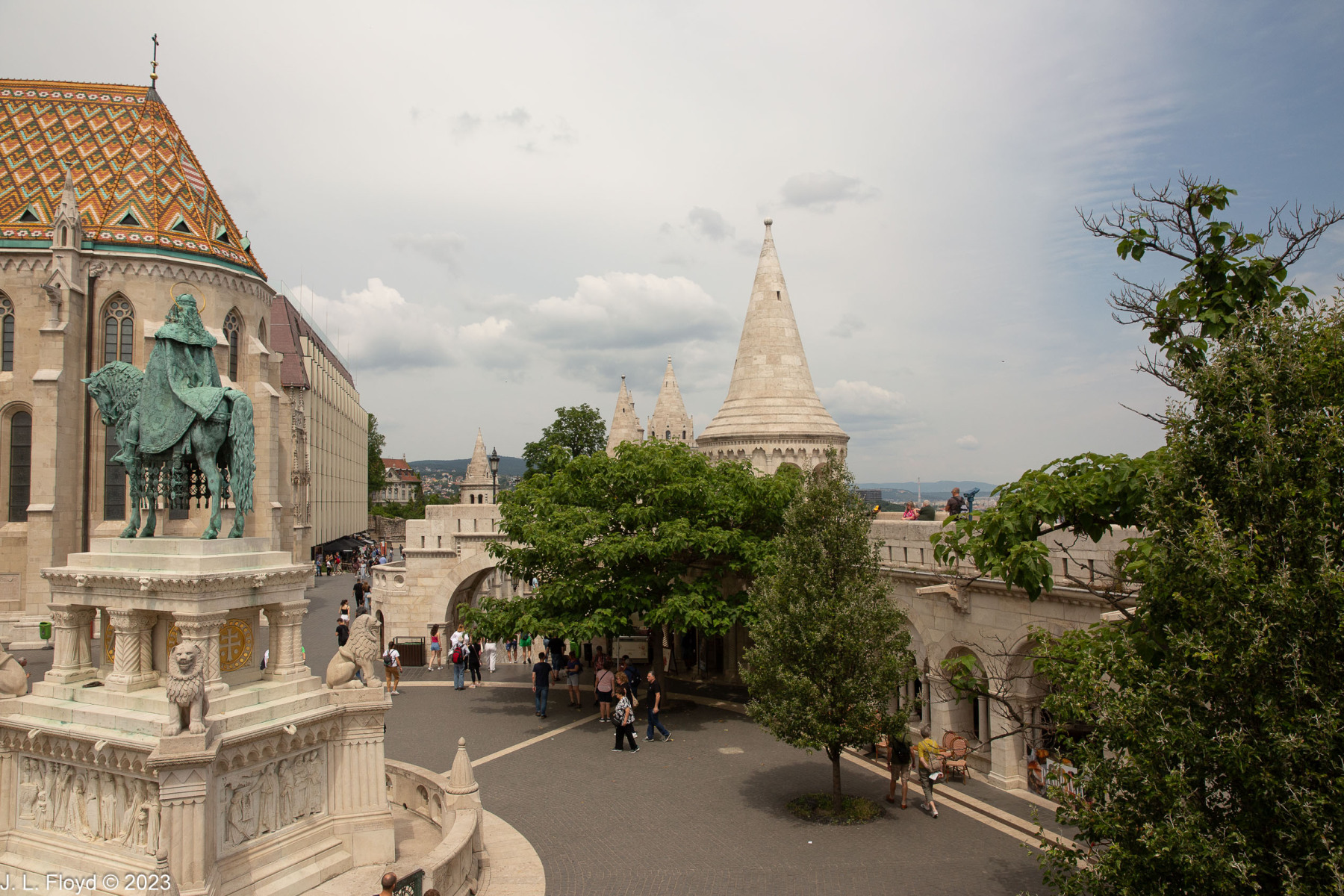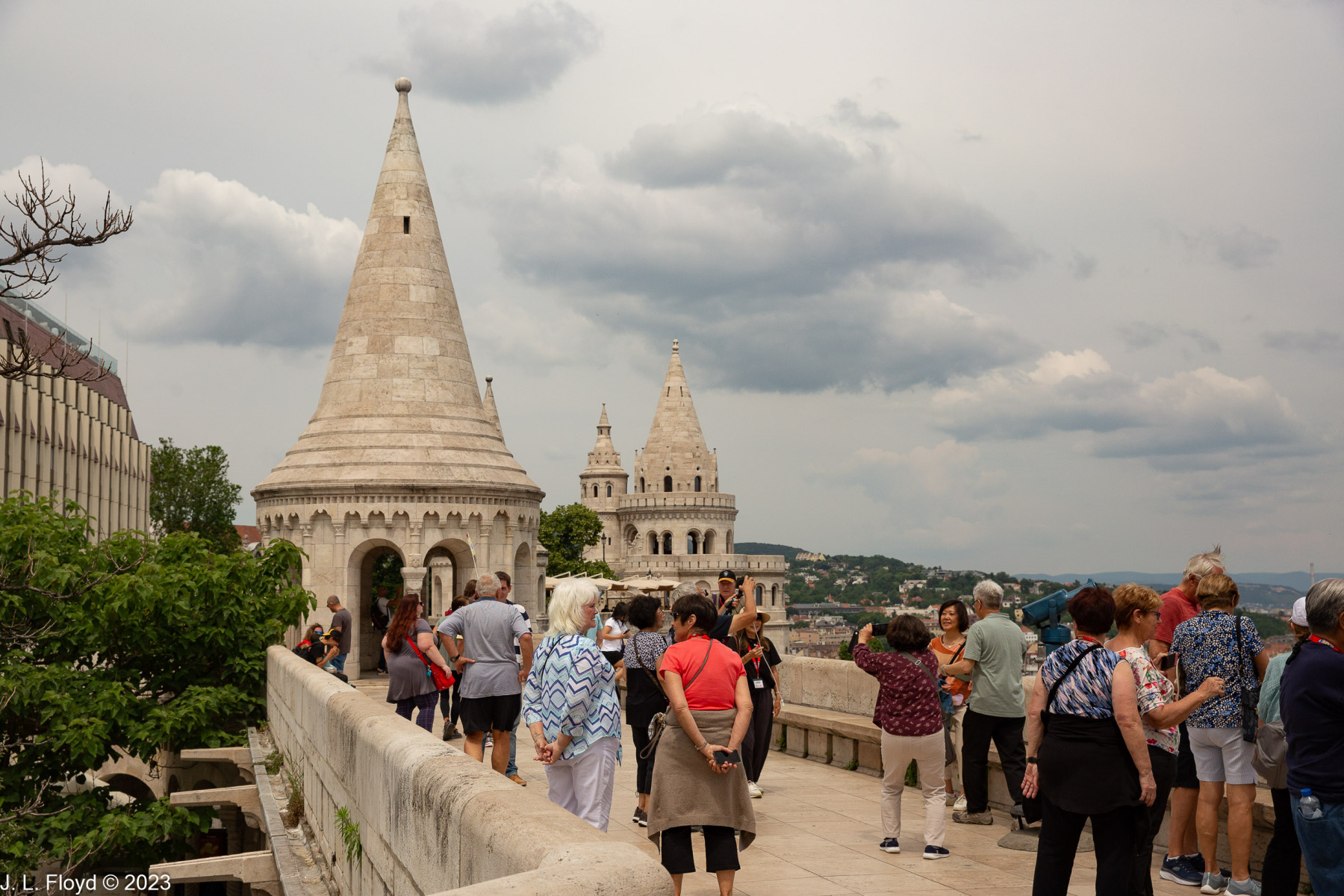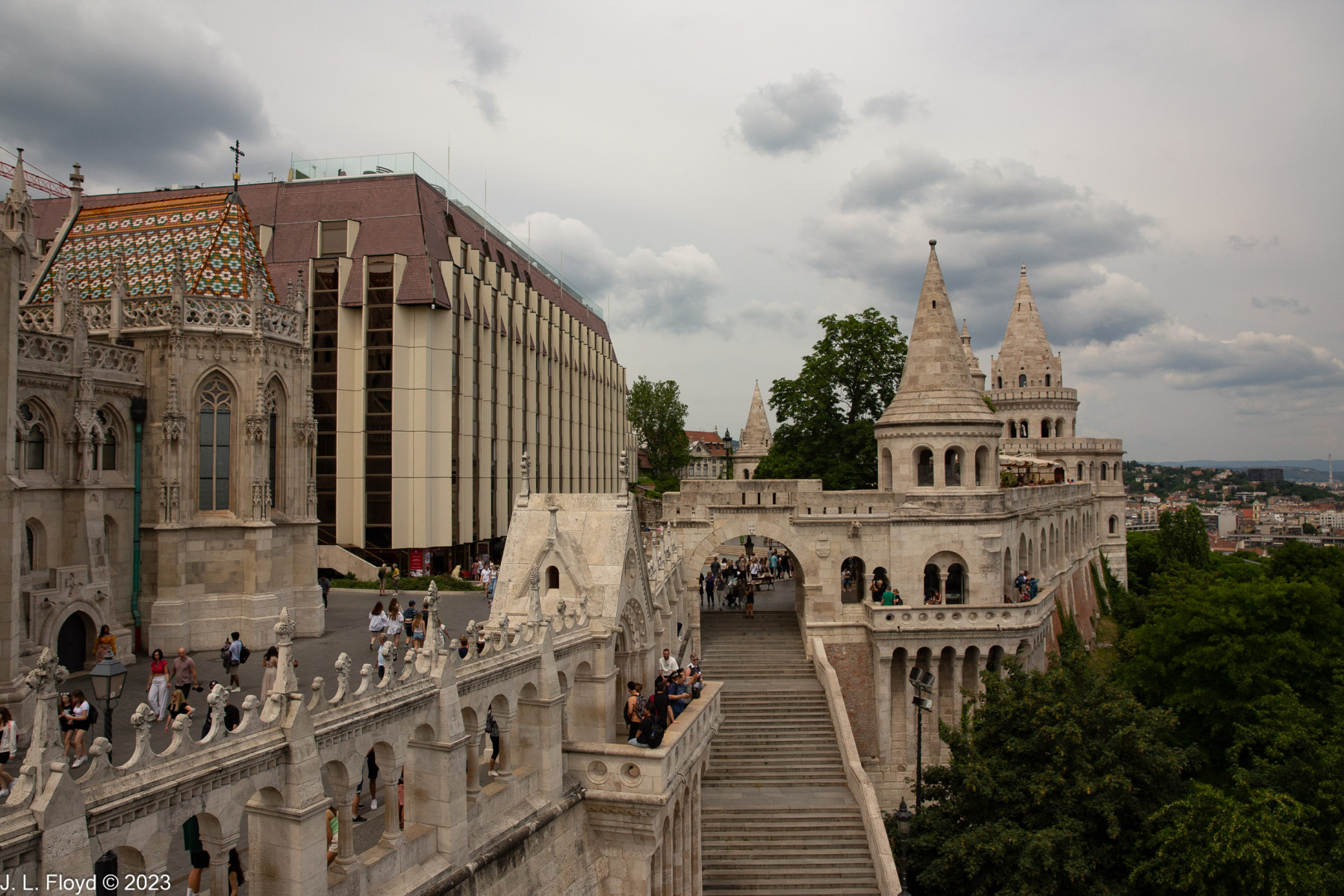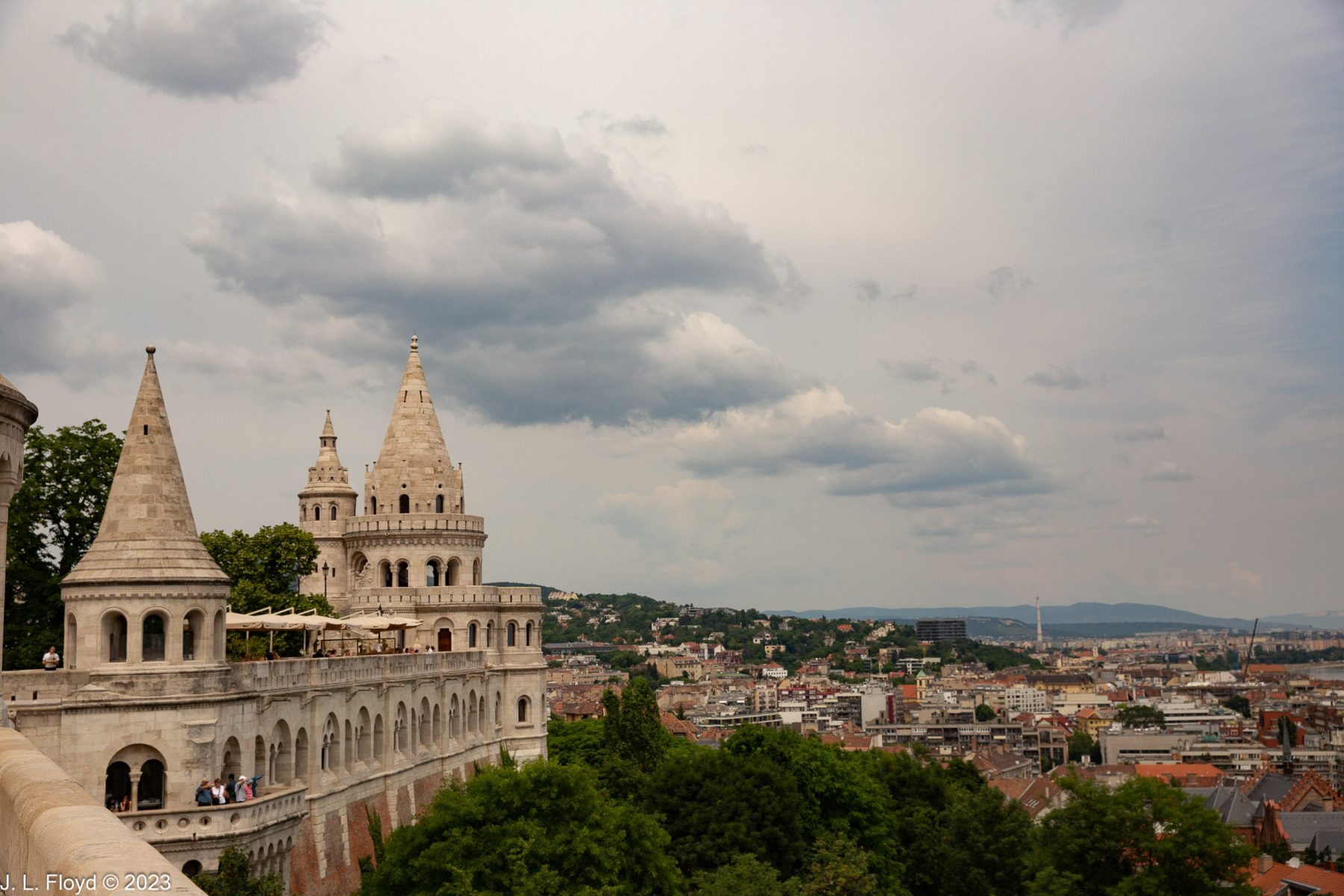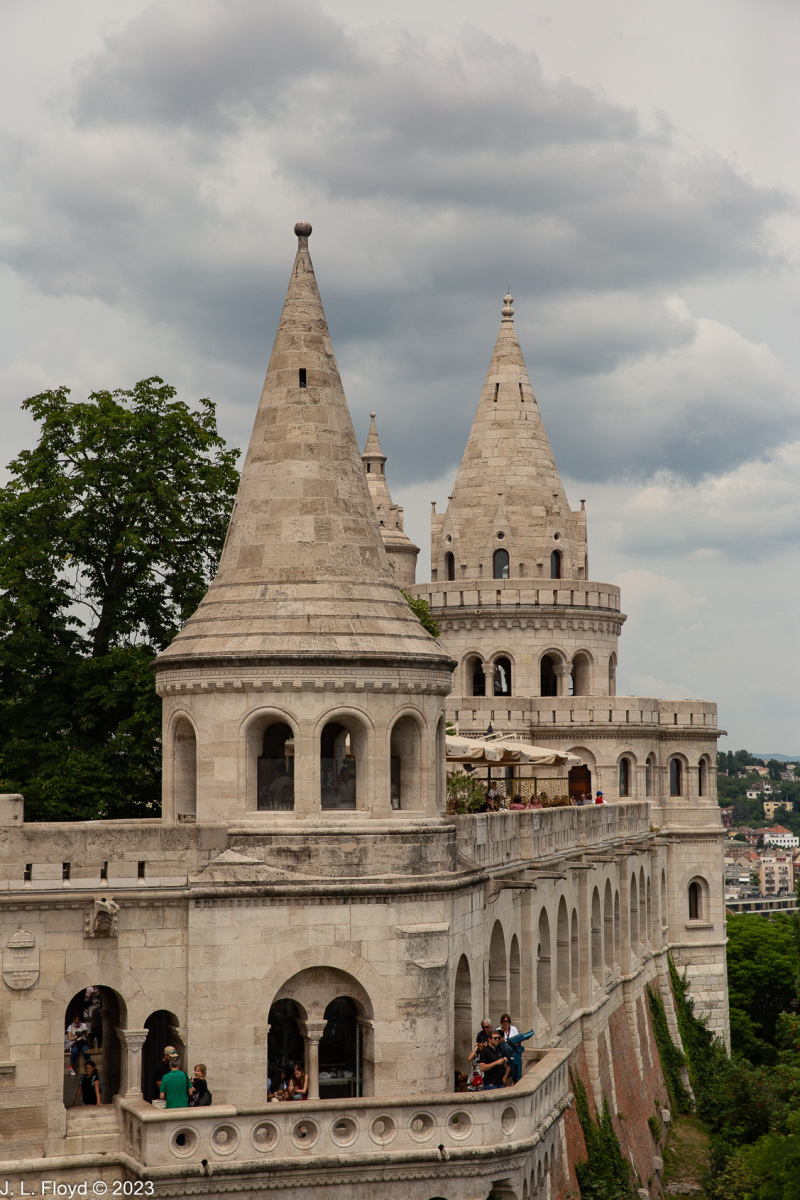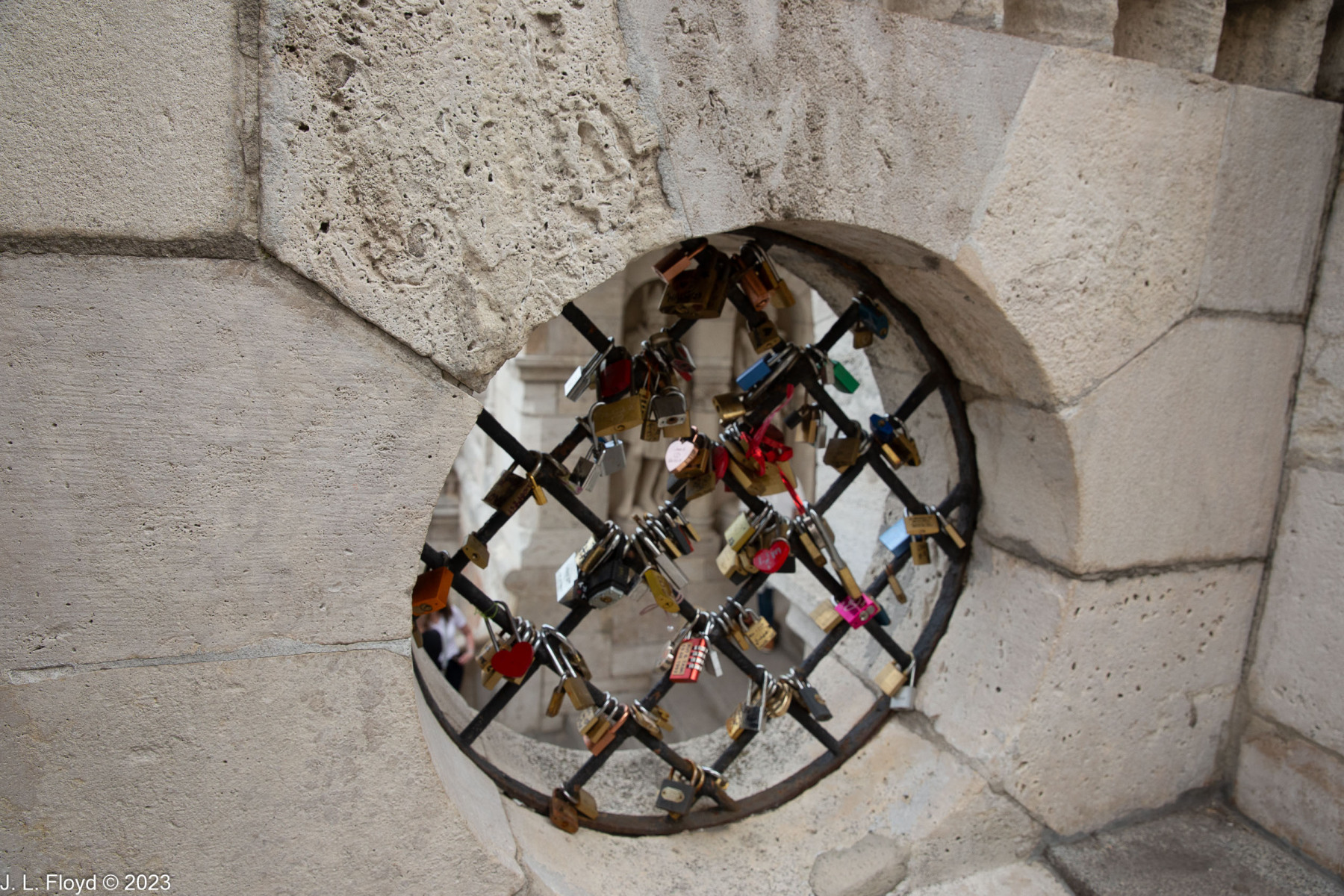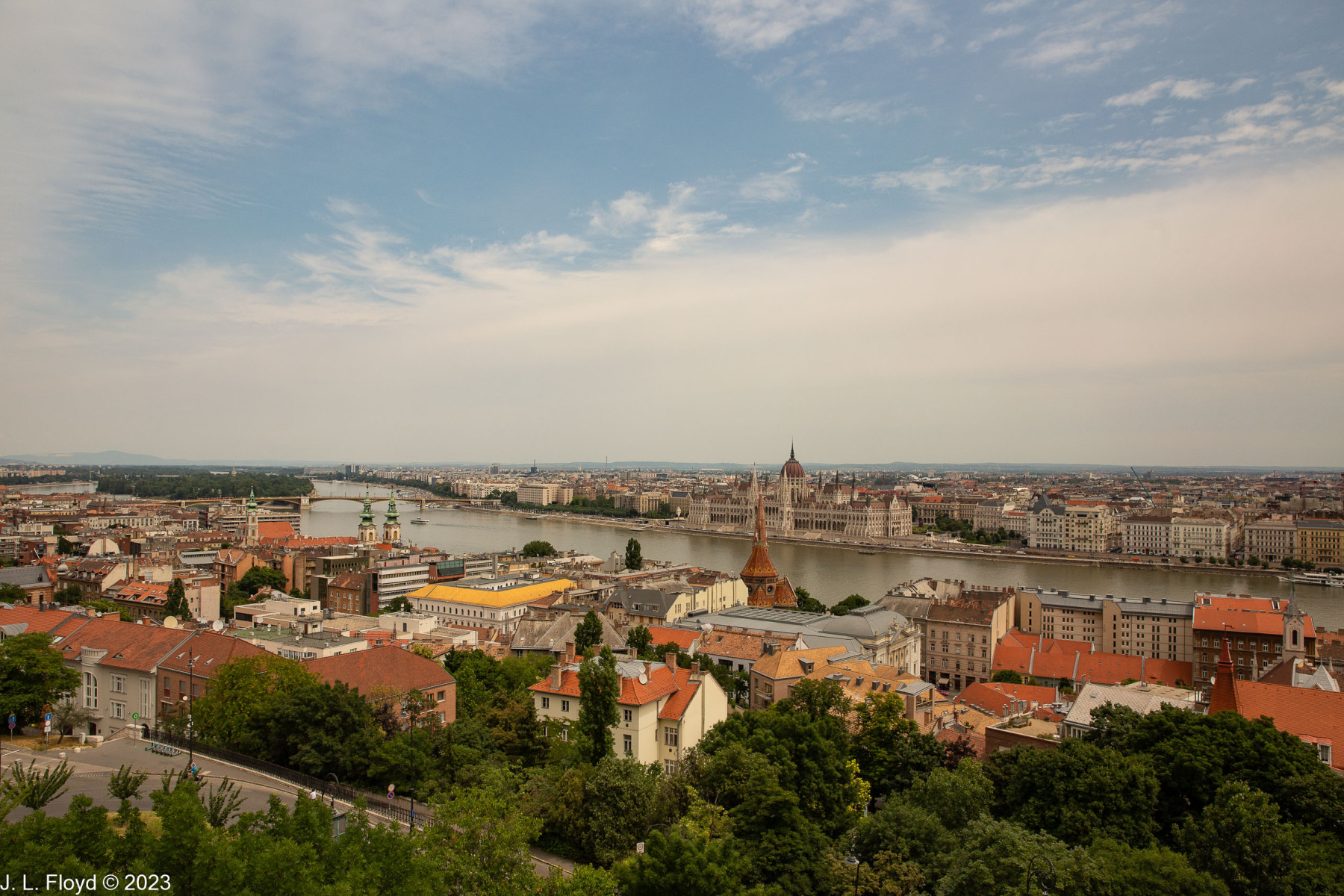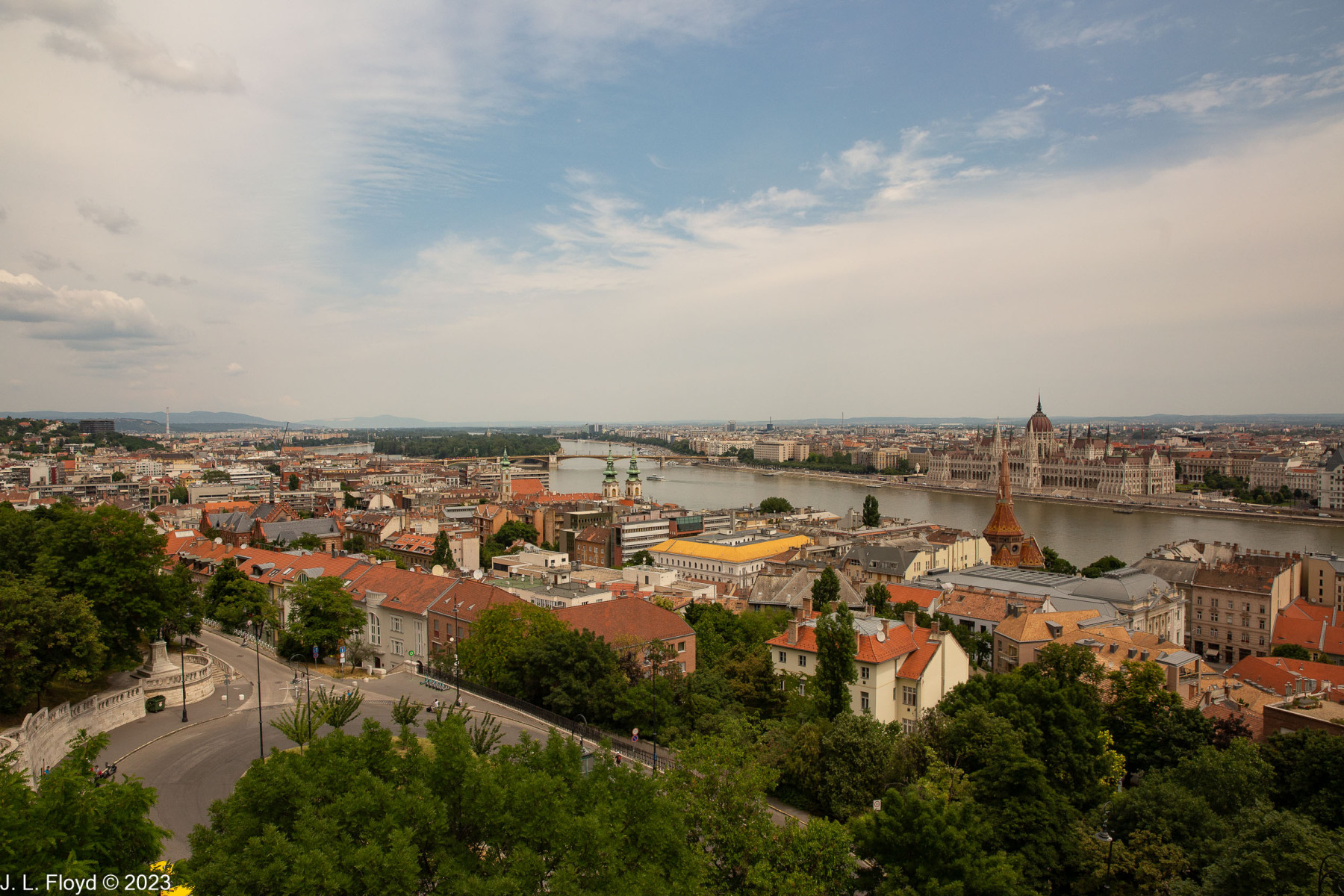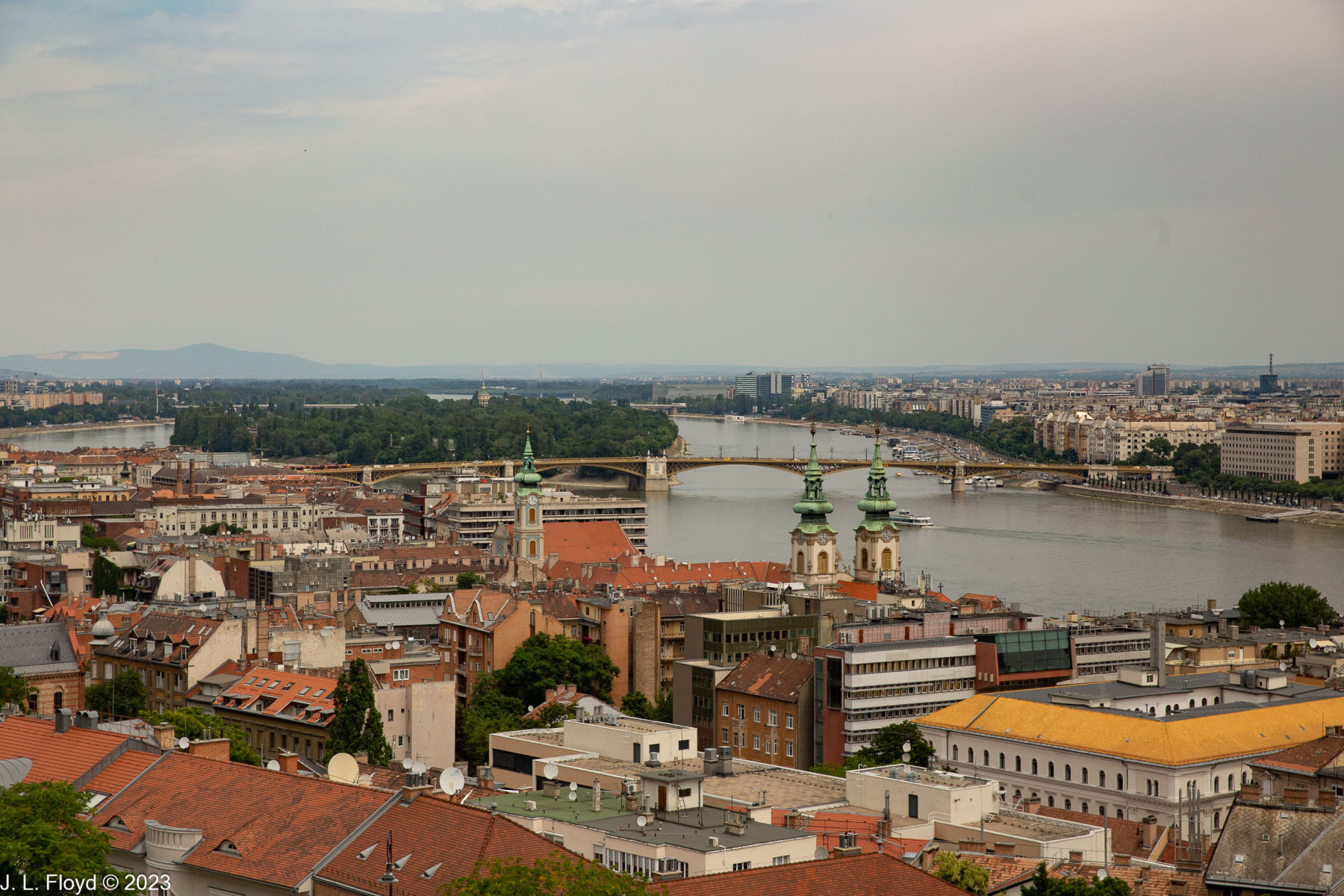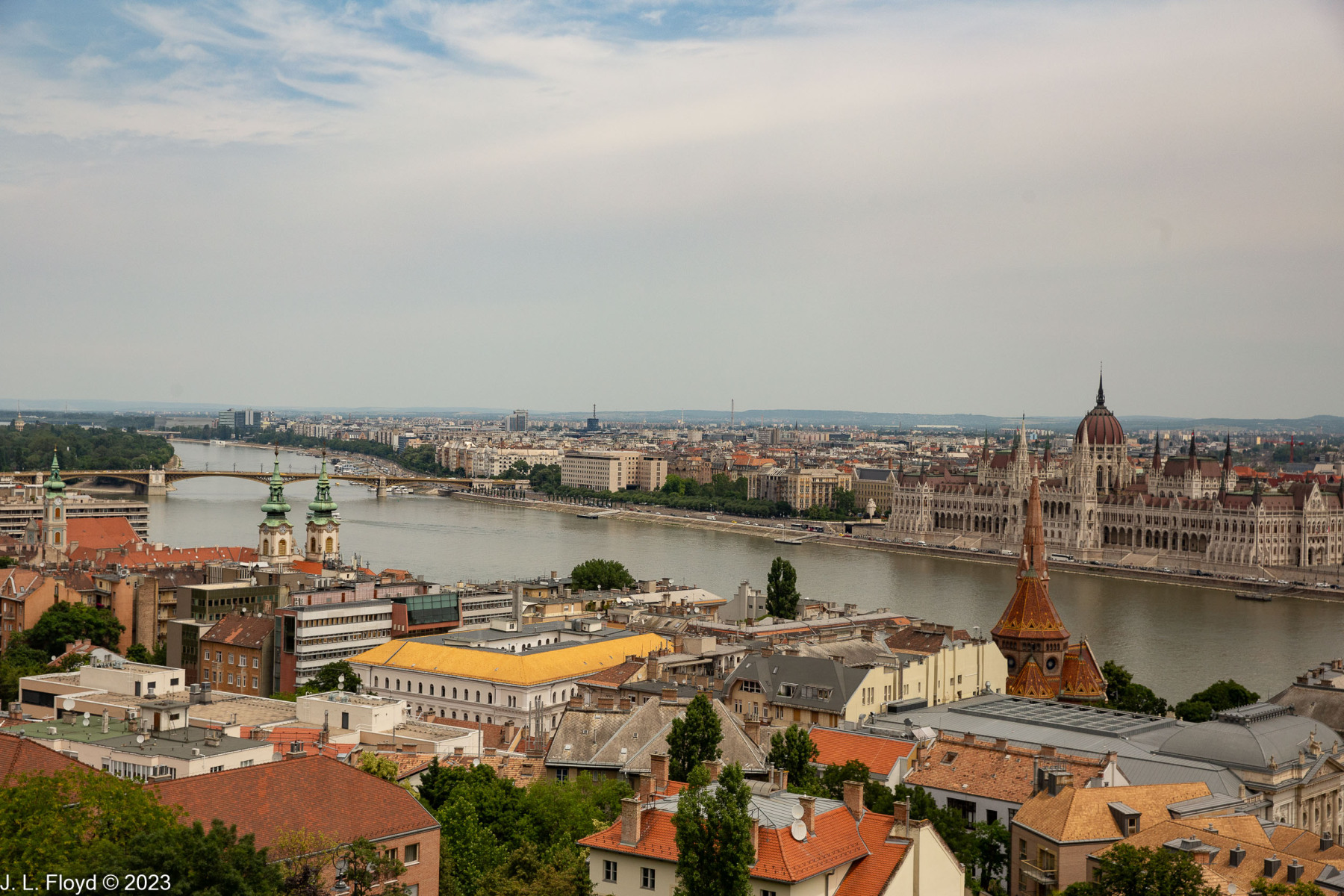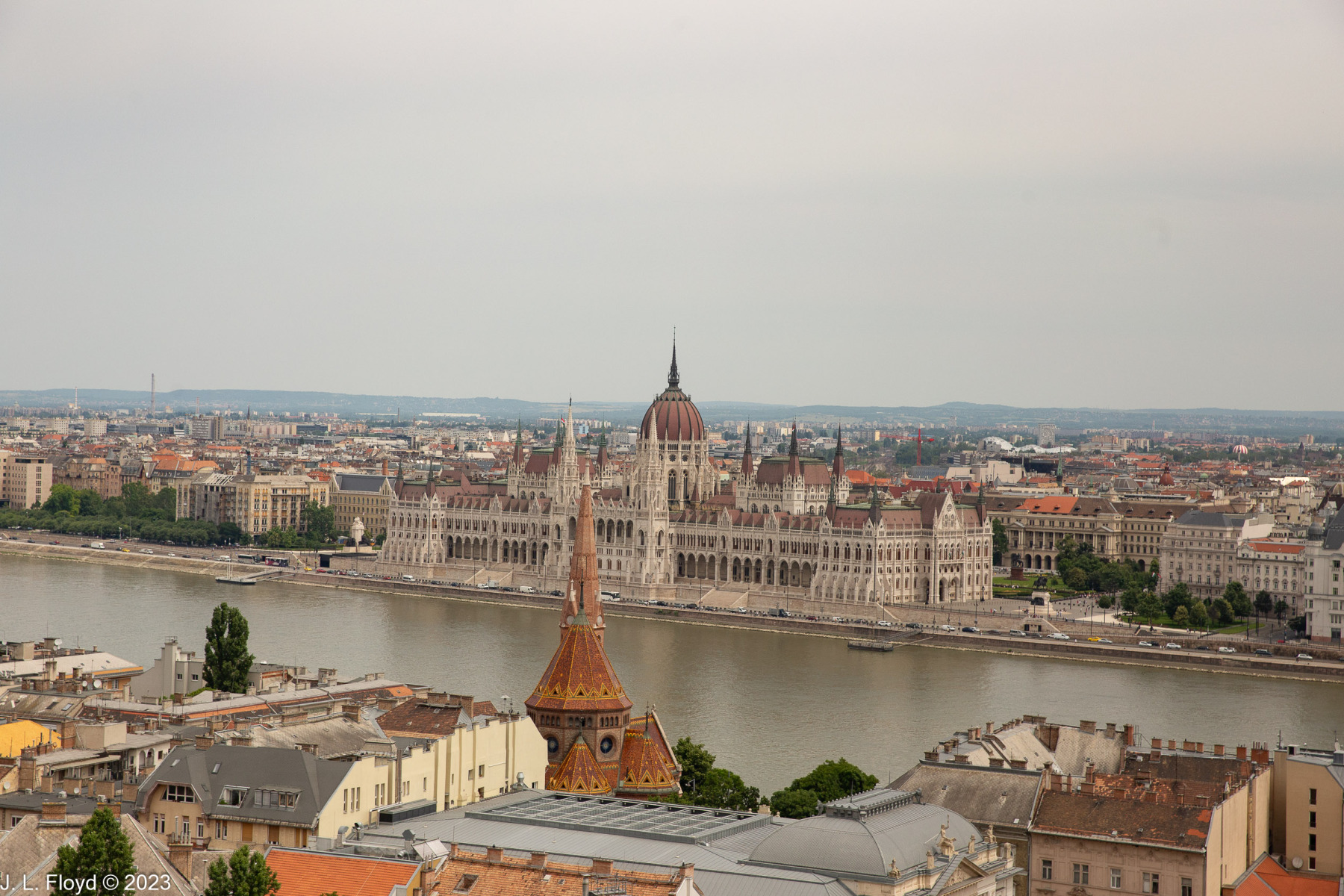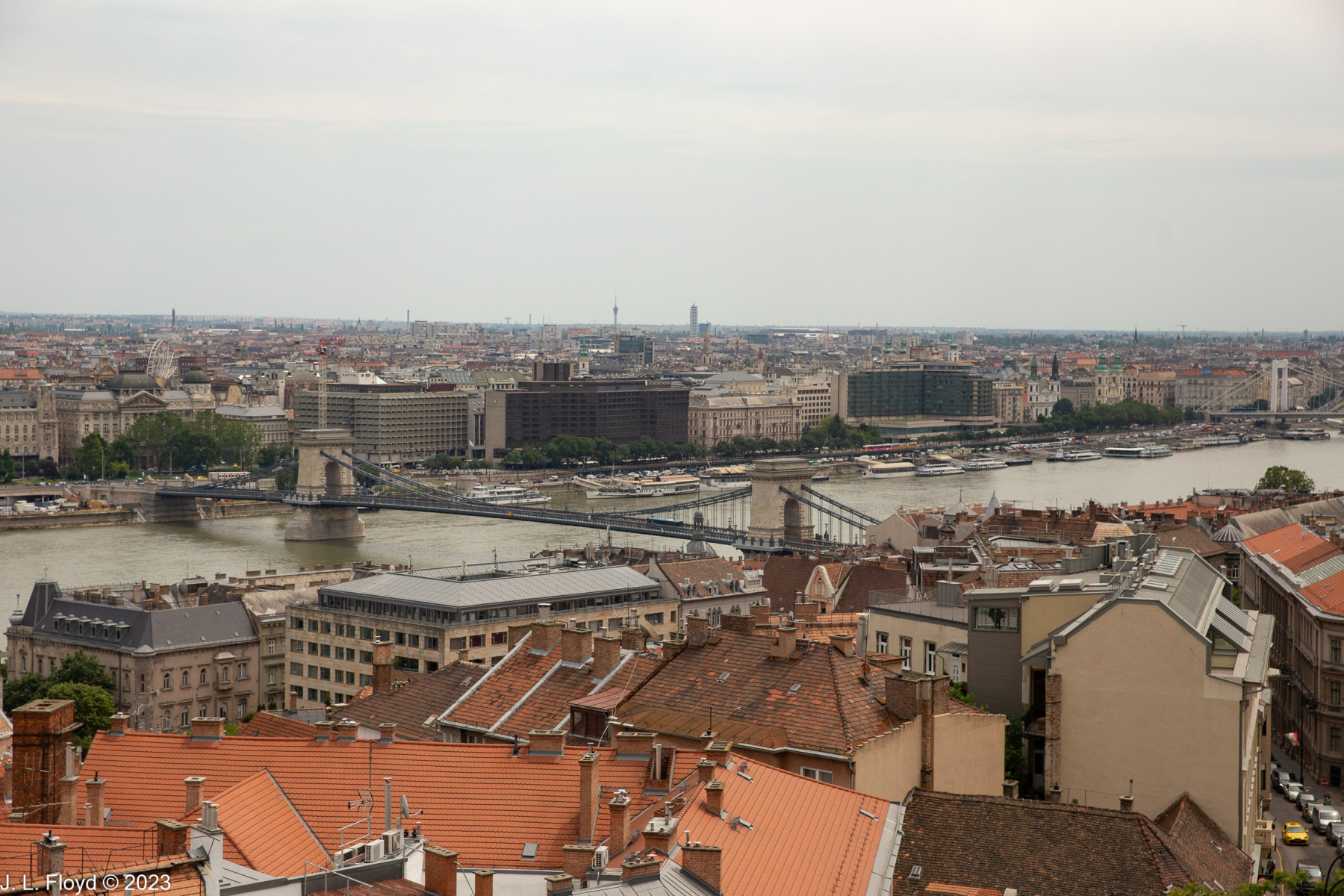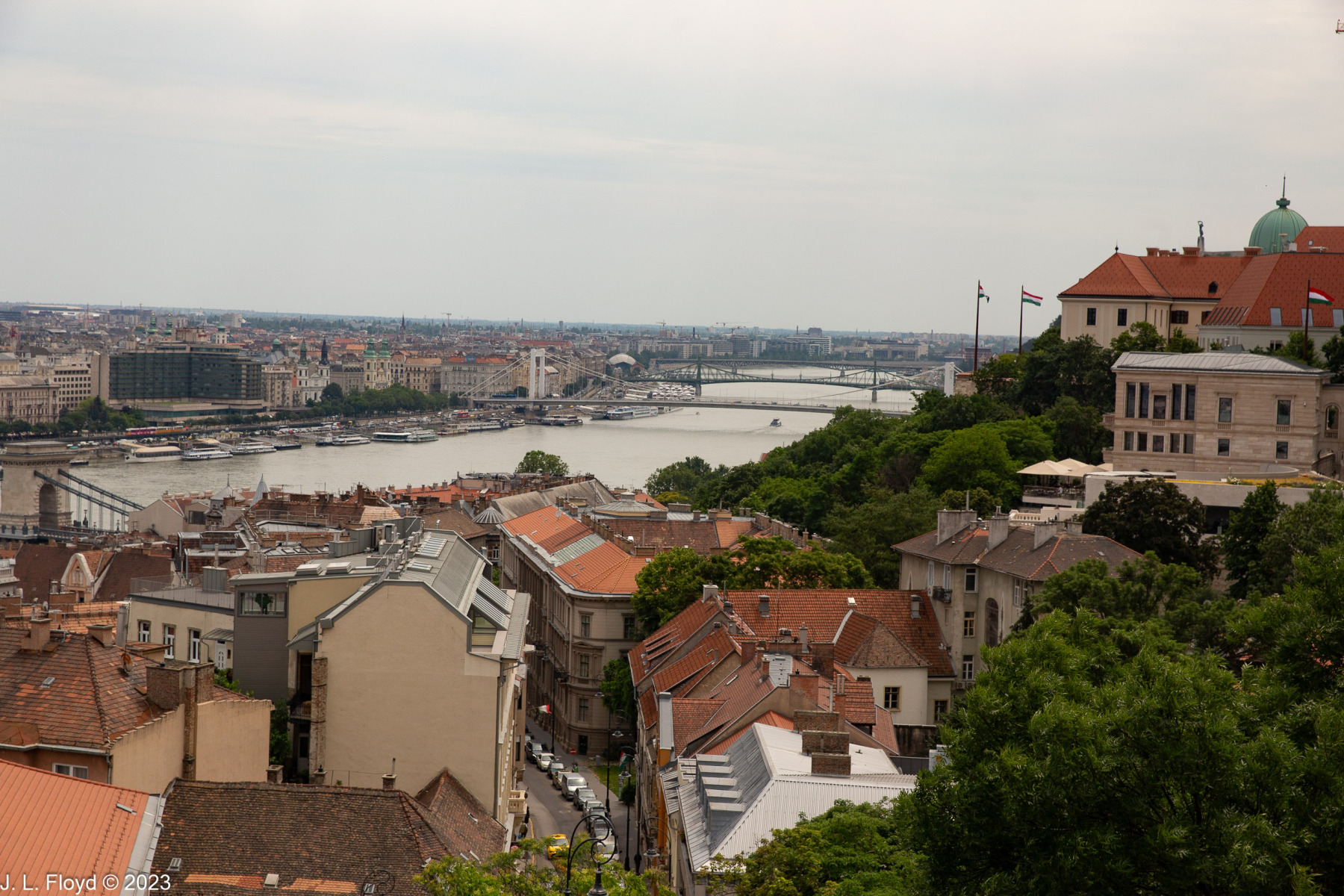After leaving Buda Palace, we headed north to see the rest of Castle Hill: Holy Trinity Square, St. Matthew’s Church and Fishermen’s Bastion.
To get to Holy Trinity Square, we traipsed back past the Old Hussar and Disz Square, then down picturesque Tarnok Street, where we passed a number of majestic monuments, seductive shops and enticing restaurants. An inconspicuous sign next to a souvenir shop indicated the way to the Labyrinth (Labirintus). This is a network of caves and tunnels under Castle Hill which has been variously used over the centuries as a refuge, dungeon, prison and bomb shelter. Supposedly Vlad the Impaler was imprisoned there for 14 years. These days it is a museum, said to be quite interesting. We didn’t have time to venture into it, but I’ll make sure to do so next time I’m in Budapest.
Arriving at Holy Trinity Square, we first encountered the Holy Trinity Monument (Szentháromság-szobor), a 15-meter (50 feet) tall column with sculptures representing the Christian Trinity on top. Lower down on the column are figures of saints, angels, cherubs and the Virgin Mary. On the base are three bas-reliefs; the central one depicts King David praying for the end of the plague which God had inflicted on the people of Israel in punishment for David’s adulterous affair with Bathsheba. That scene is the key to understanding the monument. In 1691 an outbreak of the Black Plague visited Buda and Pest, and the City Council decided to erect a Holy Trinity Column in hopes of warding off further outbreaks. The column was finished in 1706, but it didn’t work; in 1709 the Plague struck again, and the City Council decided that a bigger column was needed. This time it worked; after the unveiling of the second column, in 1713, no further plague outbreaks are recorded. Indeed, the column appears to have survived the devastation of World War II intact, though everything around it on the square lay in ruins.
Not actually on Holy Trinity Square, but I’ll mention here since it is only a block away down Holy Trinity Street, is an equestrian statue of a hussar named András Hadik, whom I had never heard of before. It turns out that he became famous for an incident that occurred during the Seven Years’ War (1756-1763). Frederick II, King of Prussia, had incurred the implacable hatred of Maria Theresa, Empress of Austria, by rudely seizing her rich province of Silesia, and she formed an alliance with France and Russia to take him down. In 1756 he invaded Saxony in an attempt to head off the Russians, who were getting ready to send troops to aid Maria Theresa. This was where András Hadik stepped in, or rather rode in. Evading Frederick’s army – Frederick II wasn’t much of a cavalry guy, his forte was infantry – Hadik wheeled his 5,000 hussars around in back of the Prussians and seized Berlin. This didn’t stop the war, but Frederick had to pay 300,000 thalers to ransom his capital. Hadik distributed the sum among his men, and Maria Theresa made him a Field Marshal.
The premier attractions of Trinity Square are Fishermen’s Bastion and the Matthias Church (Mátyás-templom in Hungarian). The church spire is visible from afar and there is no mistaking it. It is not Saint Matthias’s church because the man whose name it bears, King Matthias, unlike some other Hungarian kings, didn’t become a saint. Anyway, the official name is Church of the Assumption of the Buda Castle; Mátyás-templom is the popular name. It is not the largest church in Budapest, but it is the most historic. In one incarnation or another, it has been the scene of numerous major events, including several coronations of Hungarian kings and both marriages of King Matthias.
And indeed the church has been through several major incarnations as well as a number of minor renovations. The first church was built on the site around 1015 CE, but it was destroyed by the Mongols (1241). It was replaced by a Gothic version, begun in 1255; construction and remodeling continued over the following two centuries, with the most memorable addition, the bell tower, erected in 1470, during the reign of King Matthias Corvinus – hence its common name.
When the Ottoman Turks occupied Buda in 1541, they turned the Matthias Church into a mosque, discarded the Christian accoutrements, and plastered over the Christian paintings on the walls.
In 1686 the Christian Holy League came to take it all back. Struck by cannonballs, one wall of the Matthias Mosque collapsed, revealing a statue of the Virgin Mary hidden until then behind it, causing costernation among the Muslim defenders, who thereupon surrendered. This became famous as the “Marian Miracle.”
Of course the Matthias Church had to be rebuilt, and this time most of the accretions were Baroque in style, especially in the interior. Fast forward to the 19th century: another major rebuilding of the Matthias Church takes place, under the direction of the Hungarian architect Frigyes Schulek, and by order of King Franz Joseph. The aim was to restore the Gothic church in its pristine glory; this could not be completely realized because too much had been lost, and Schulek introduced a number of elements of his own creation when he could not replicate the originals, or where he saw room for improvement. For instance, the colorful diamond pattern roof tiles were his doing. Although his work was somewhat controversial in its day, it is now considered a masterpiece of Hungarian neo-Gothic architecture.
Of course the church was mostly destroyed again in World War II, except for the bell tower, but it was subsequently restored and was in splendid condition when we visited.
The interior of the Matthias Church is also largely the work of Frigyes Schulek and his associates, though there are some significant survivals from earlier periods, and they took pains to restore the original appearance wherever possible. The stained glass windows, the murals in the side chapels, the reconstructed 1690 altarpiece, and several chapels are among the fruit of their efforts. One outstanding new addition, at least to my unsophisticated eye, is the pulpit, which was created from an original design by Schulek himself, and executed by a number of different artists.
The Fishermen’s Bastion or Halászbástya, as it is known in Hungarian, runs behind the Matthias Church and encloses part of Trinity Square. Its name originated with the historical circumstance that the guild of fishermen was supposedly responsible for defending this area of the city in earlier times.
In the space enclosed in the walls of the Bastion stands a large equestrian statue of St. Stephen (István in Hungarian), the first king of Hungary, who lived from reigned from 1000 until his death in 1038. and is credited with permanently establishing Christianity in Hungary.
Fishermen’s Bastion is a monument in the form of a castle wall, overlooking the Danube, with seven stone towers along its length. The towers represent the seven Magyar chieftains who became the founders of Hungary. They are described as Neo-Romanesque, but the conical shape of the towers gives them what seems to me a Turkish appearance. Although there were castle walls here from earlier times, the current wall was built at the end of the nineteenth century under direction of Frigyes Schulek, the same architect responsible for the restoration of the Matthias Church. Like almost everything else in Budapest, the Bastion was badly damaged in World War II and restored afterward.
As we climbed the stairs up to the walkway along the top of Fishermen’s Bastion, and at intervals along the wall, we saw steel gratings with padlocks hanging from the bars. These turned out to be the work of amorous couples who put the locks on the gratings with nametags to swear to their undying love for one another. I couldn’t help speculating on how many couples had come to place a new lock on the wall and been broken up by the discovery of another lock linking one of them to an erstwhile prior relationship. I also wondered what would happen if, after a relationship cemented with one of these locks fell apart, one of the pair showed up with boltcutters to cut off the lock.
Along the north section of the Bastion, just to the north of the Matthias Church, stands the huge block of the Hilton Hotel, opened in 1977. The northern wing was built on top of the remains of the 13th-century Dominican monastery of St. Nicholas, while the southern wing is decorated by the façade of a Jesuit’s College built at the end of the 1770s. The former tower and ruins of the monastery church lie in a courtyard between the two wings.
From the walkway on top of the Fishermen’s Bastion wall we obtained our best views of Budapest, even better than the ones from the Danubian terraces of Buda Palace.
Before we had to leave Trinity Square to catch our bus, I went back to the shops on Tarnok Street and fulfilled a small quest by buying some postcards to send to friends, and also a couple souvenir T-shirts. Unfortunately I missed the post office in the Old Town Hall nearby and failed to mail the postcards until near the end of the cruise. They didn’t arrive until more than a month afterward.
From Castle Hill our bus took us to board the Monarch Queen, which would be our home on the Danube for the following week. But since we weren’t scheduled to set sail until late the following afternoon, we still had most of a day to continue seeing Budapest, which will be the subject of the next post, and I’ll wait until I get to the tale of our departure from Budapest to relate our first experiences on board the ship.
